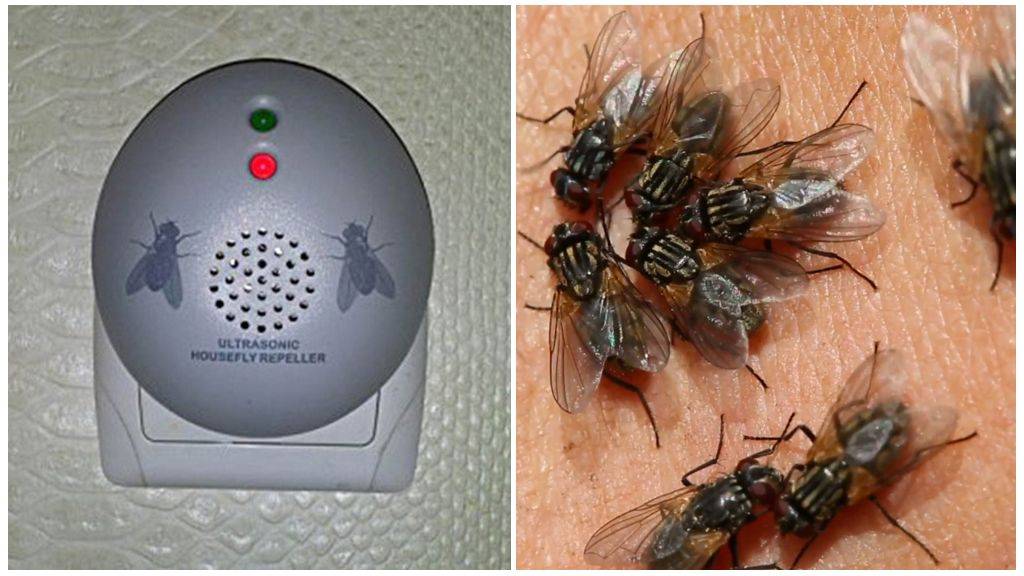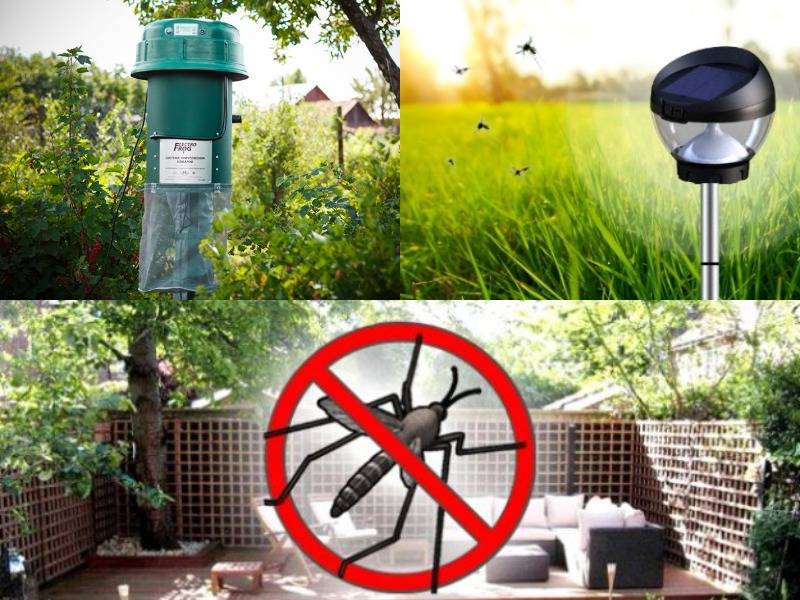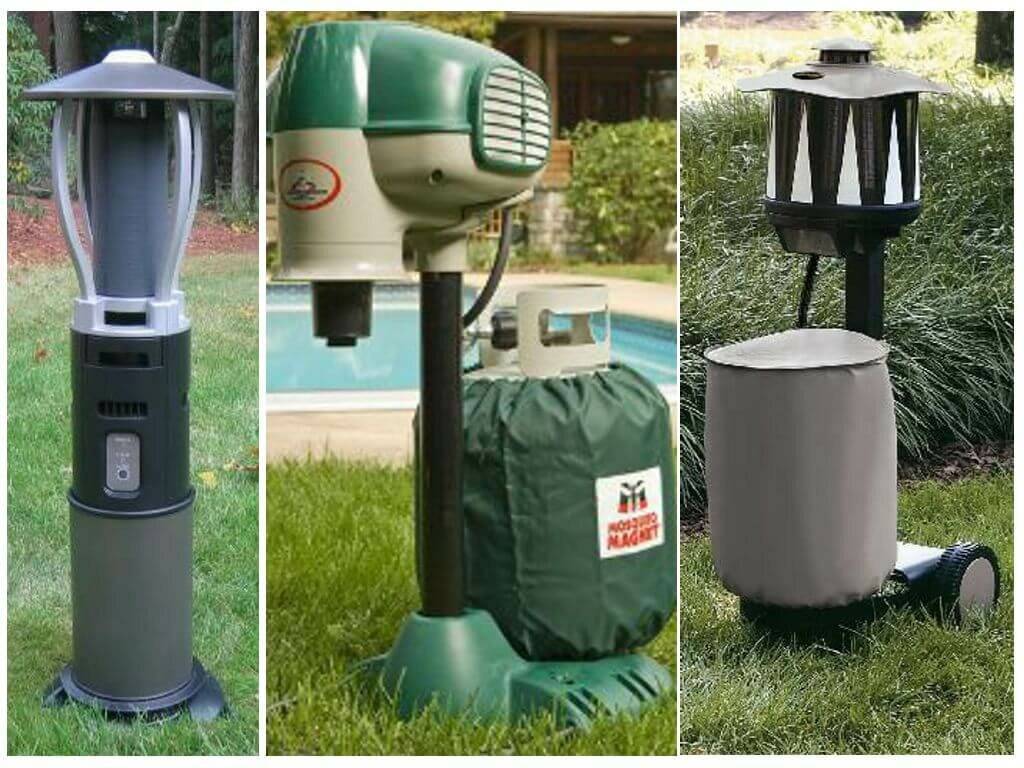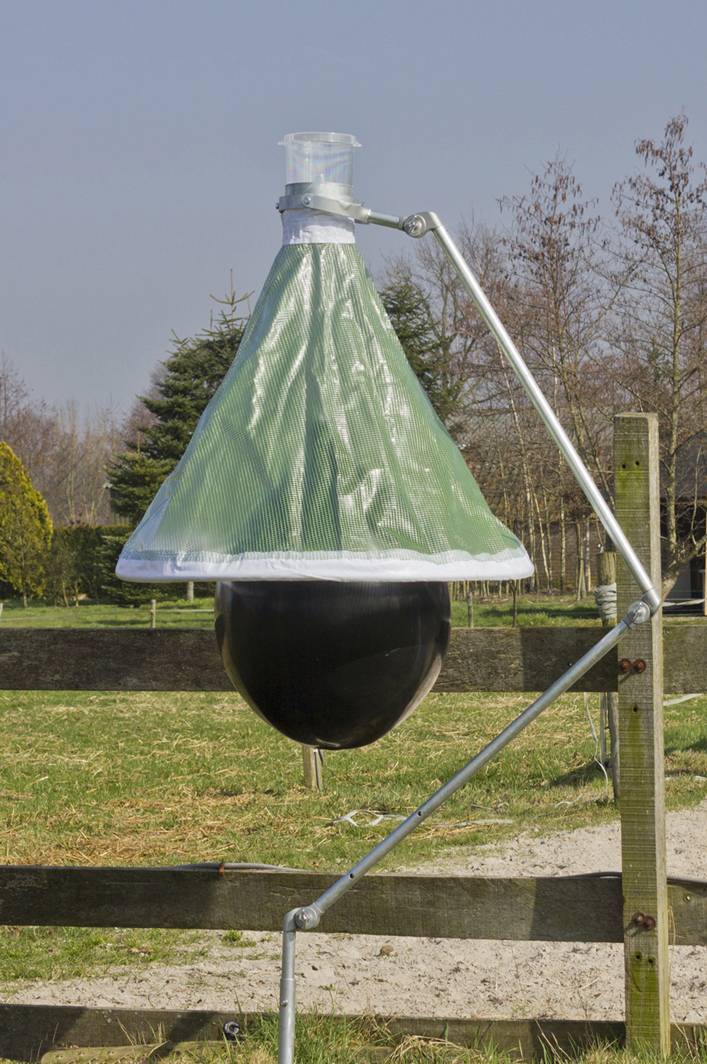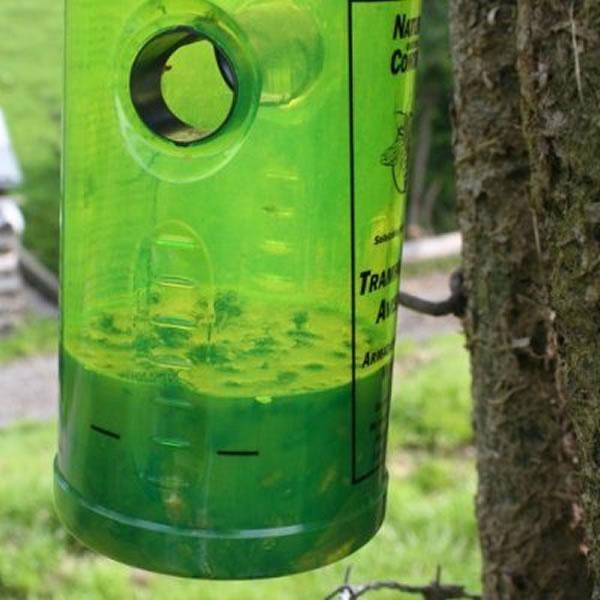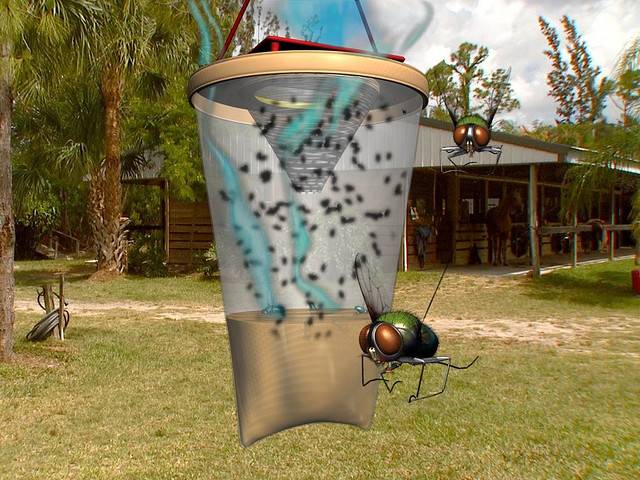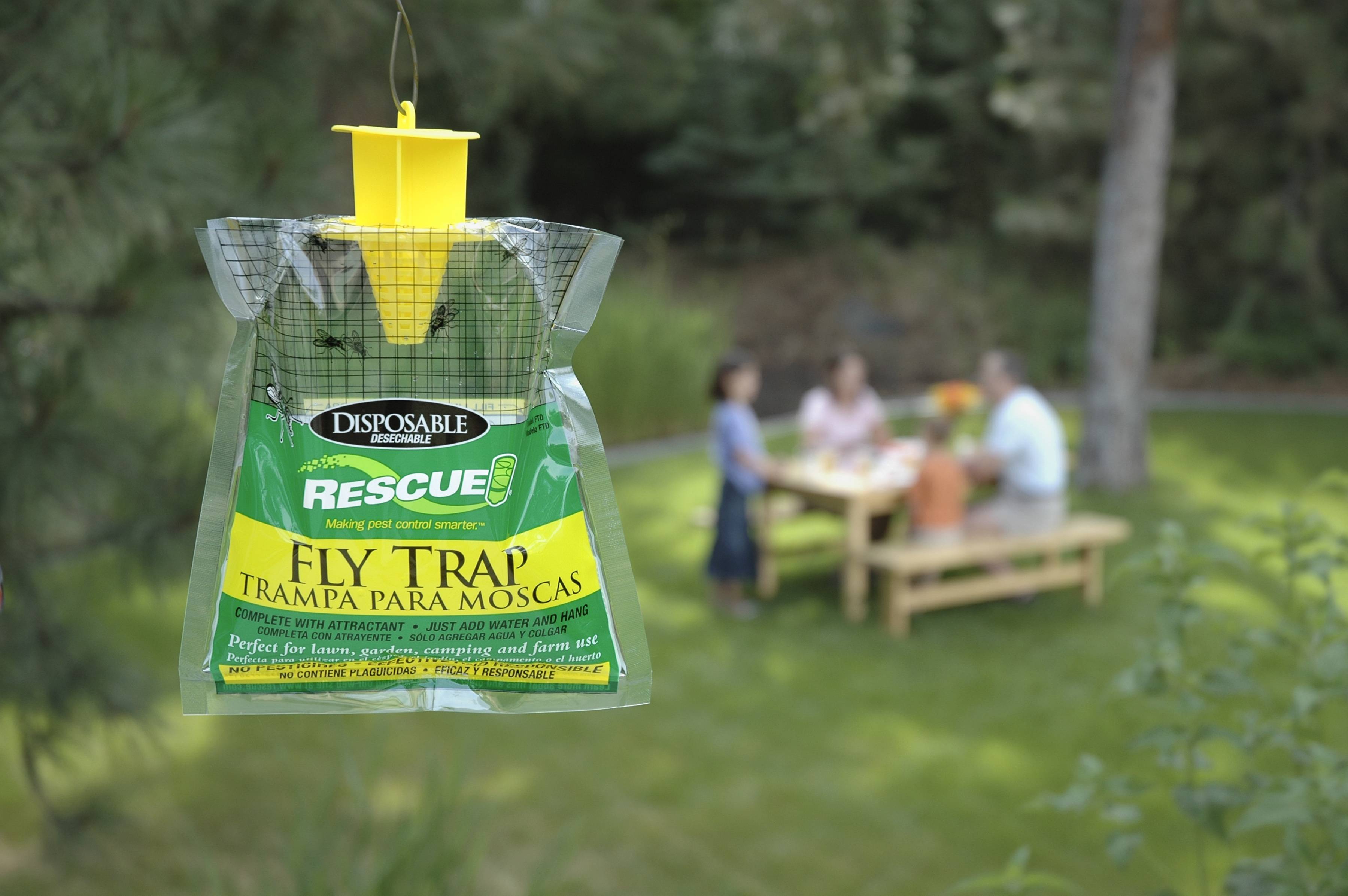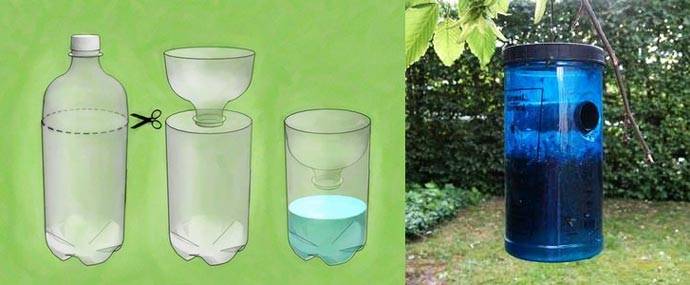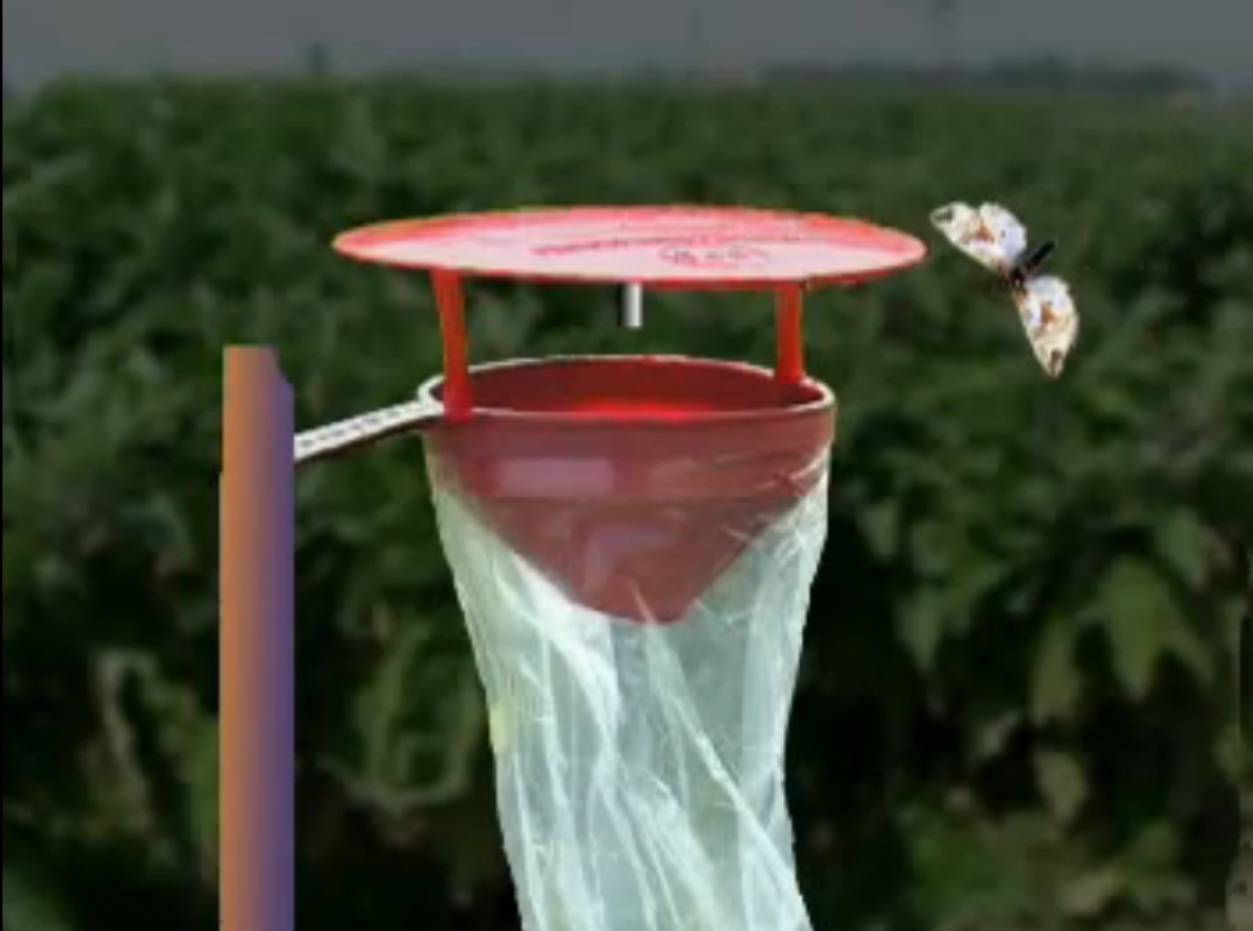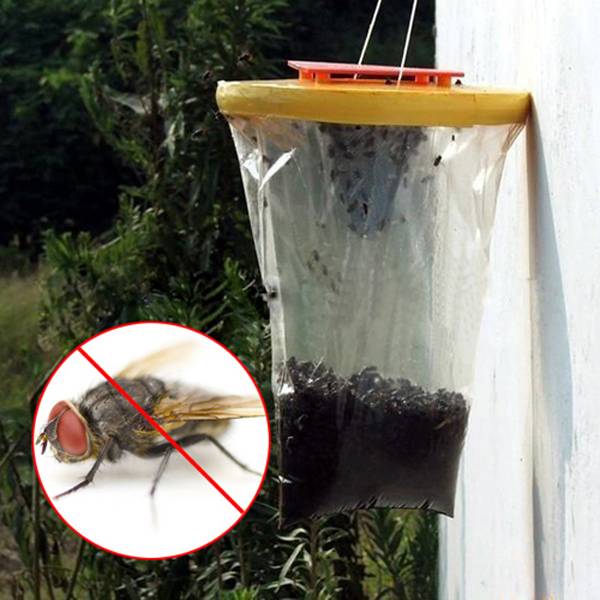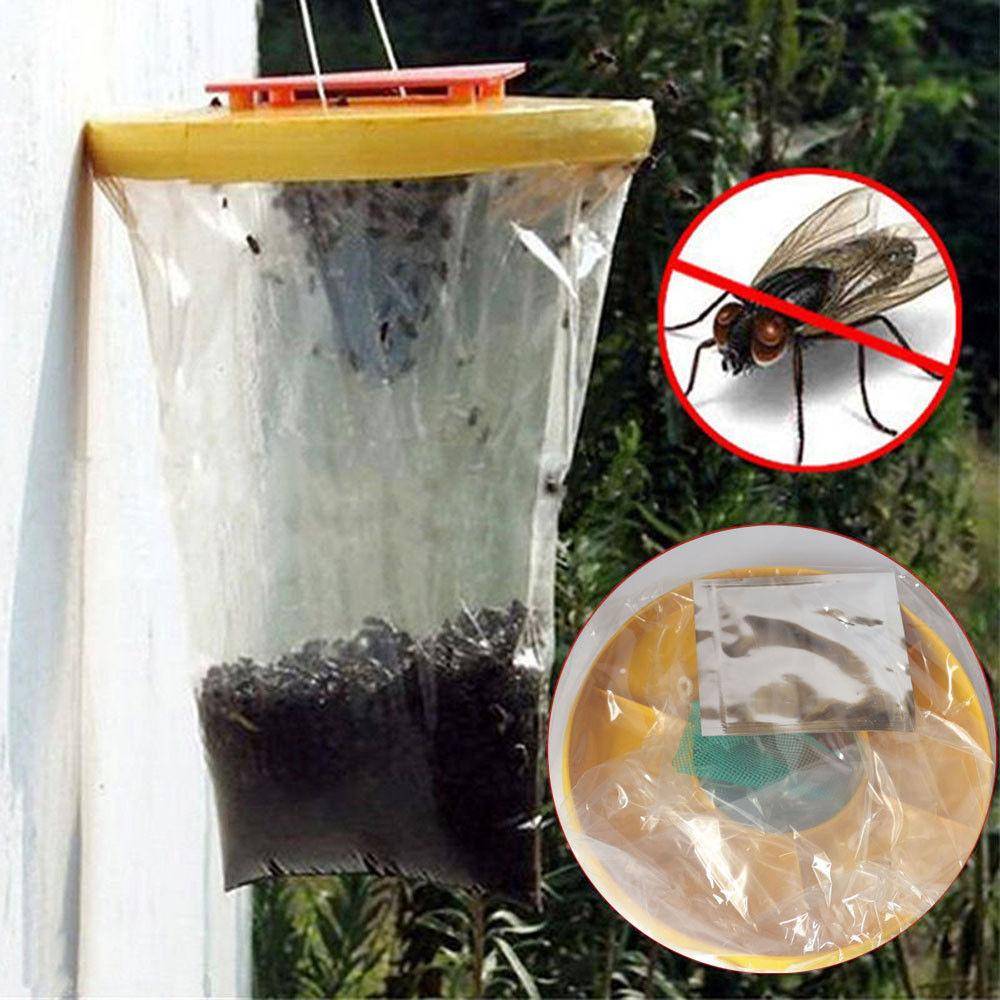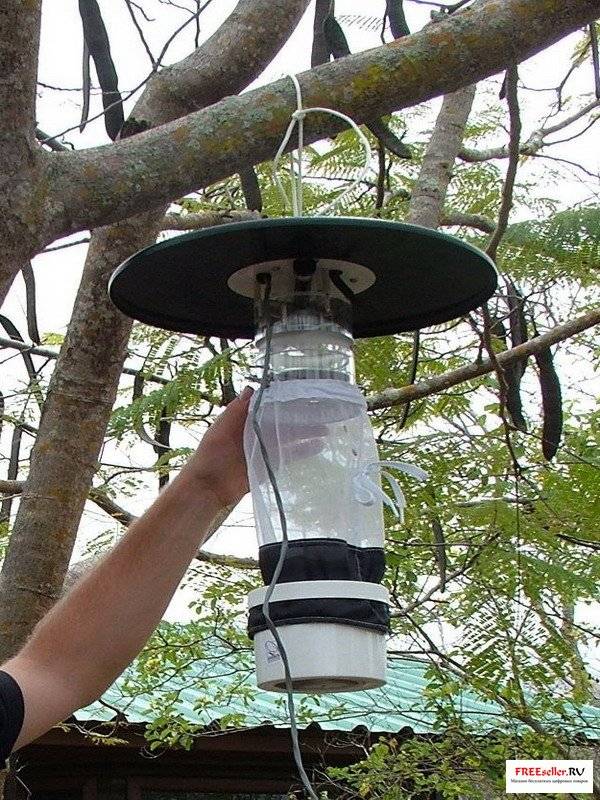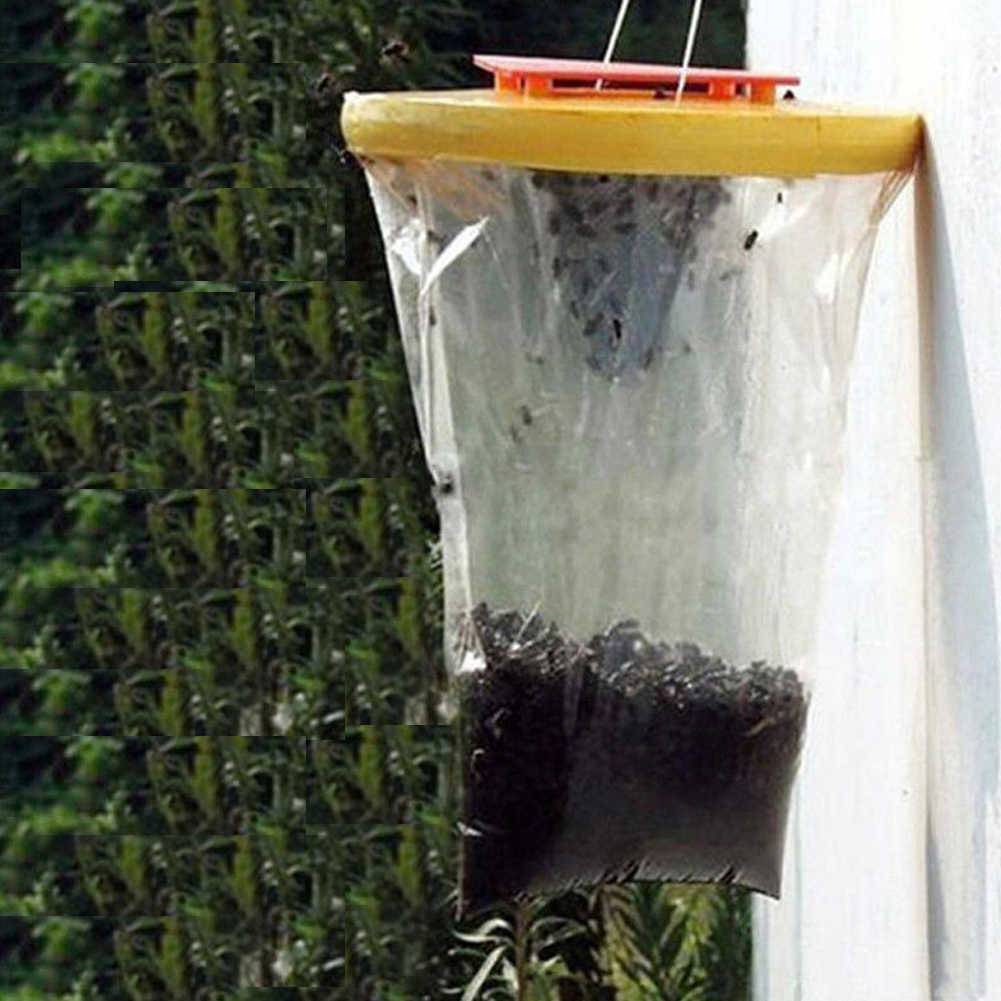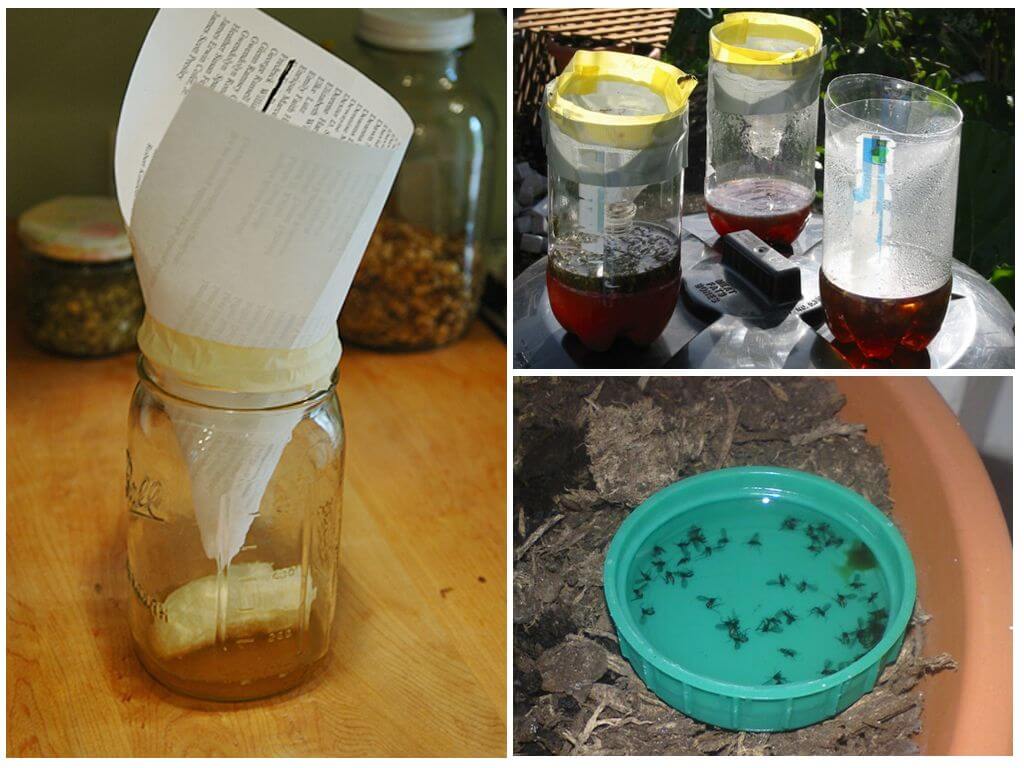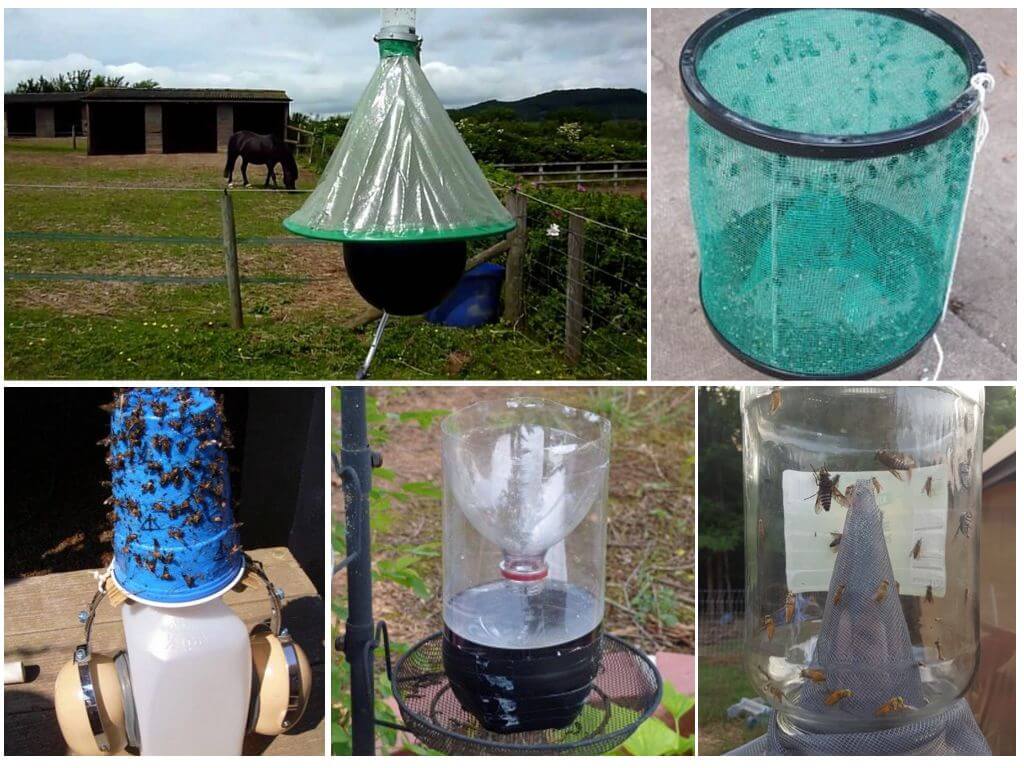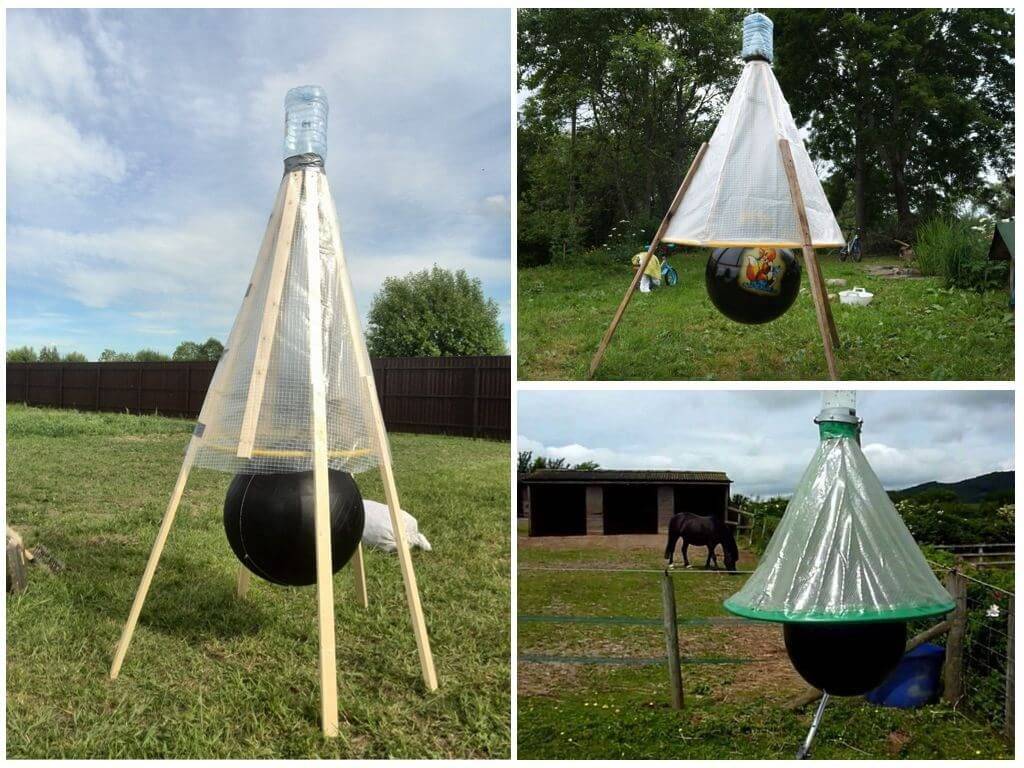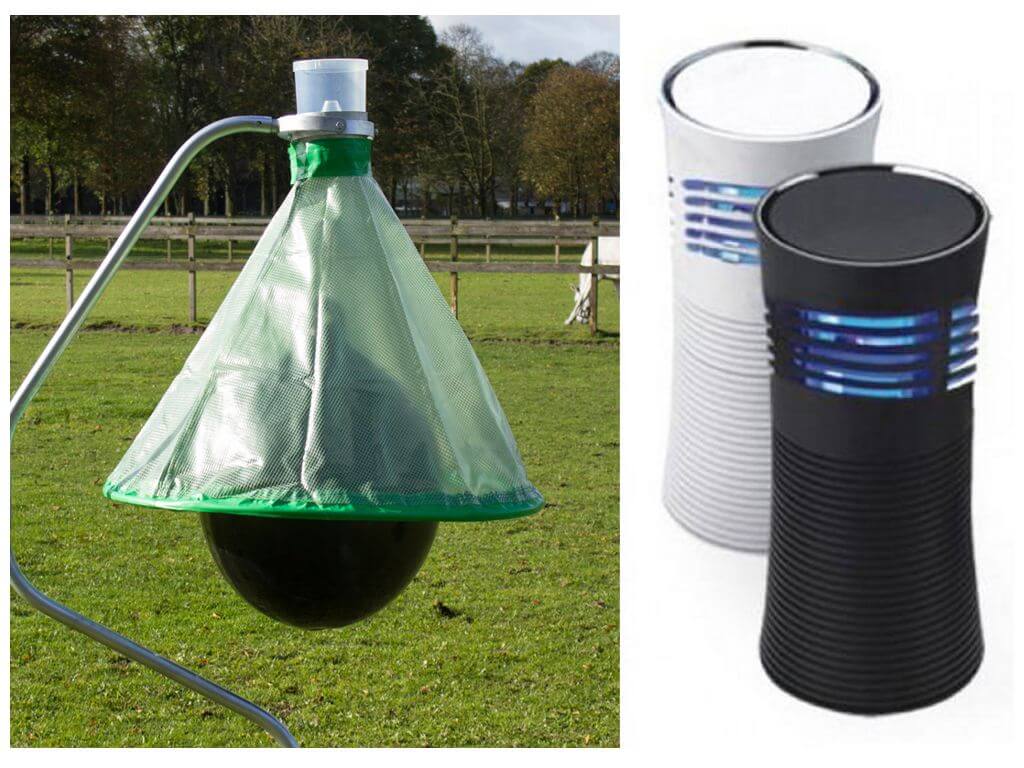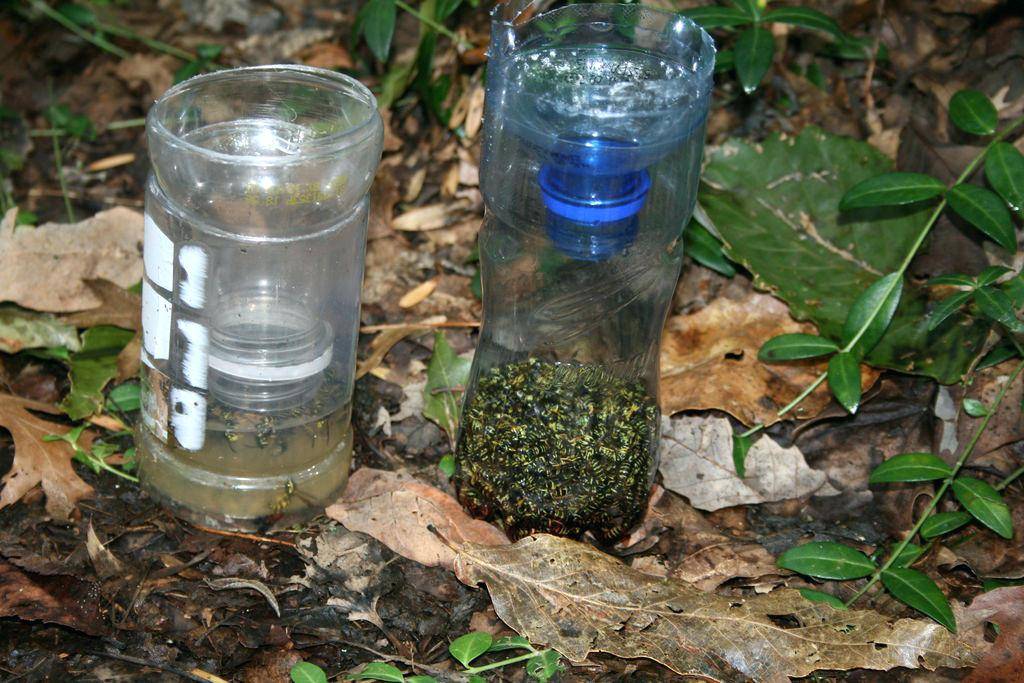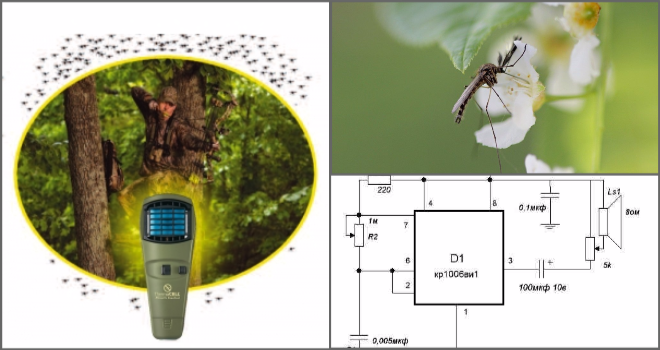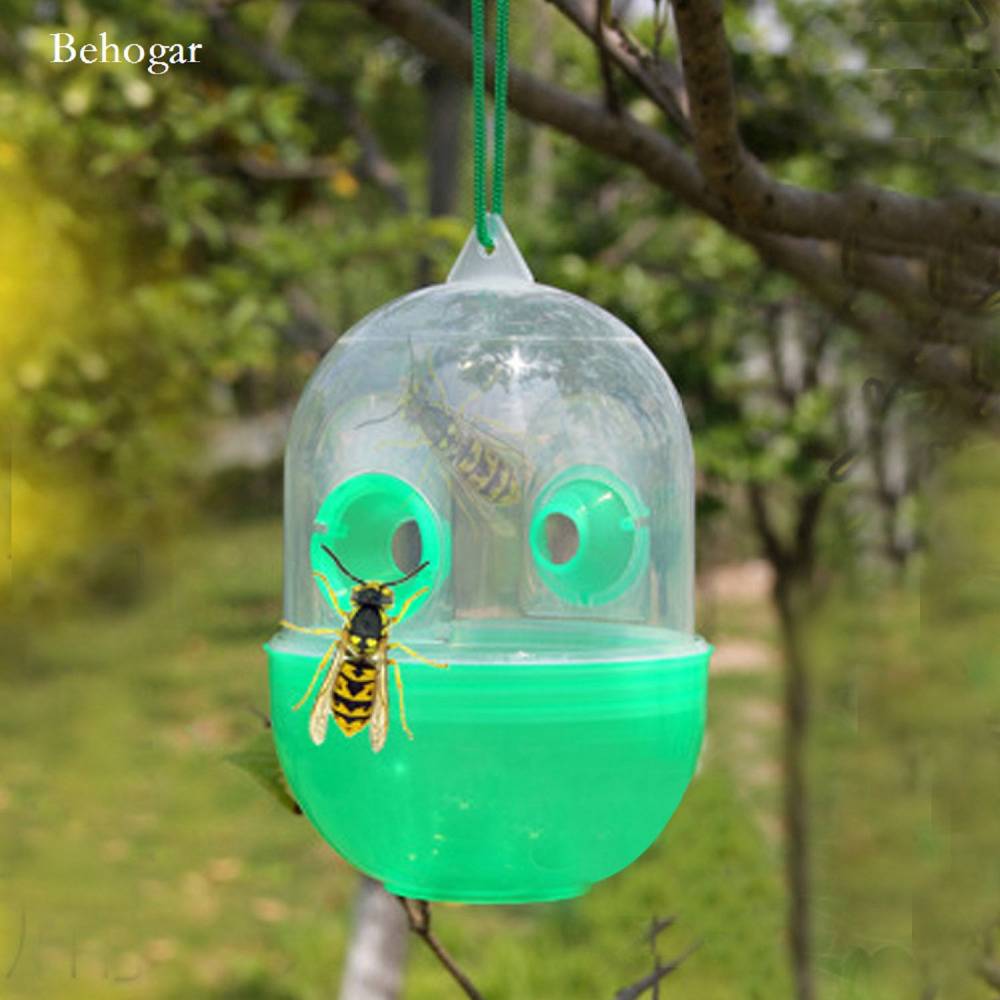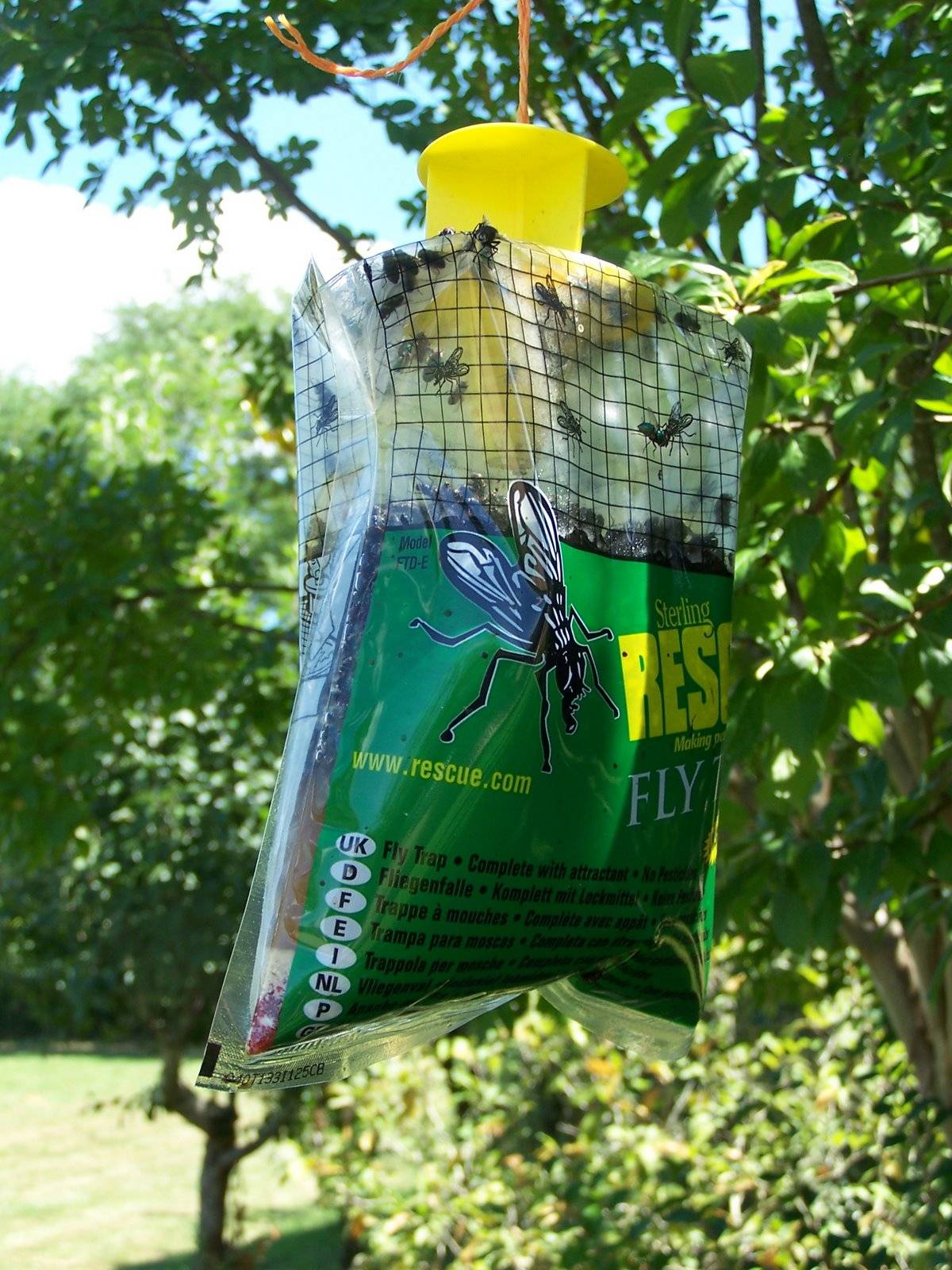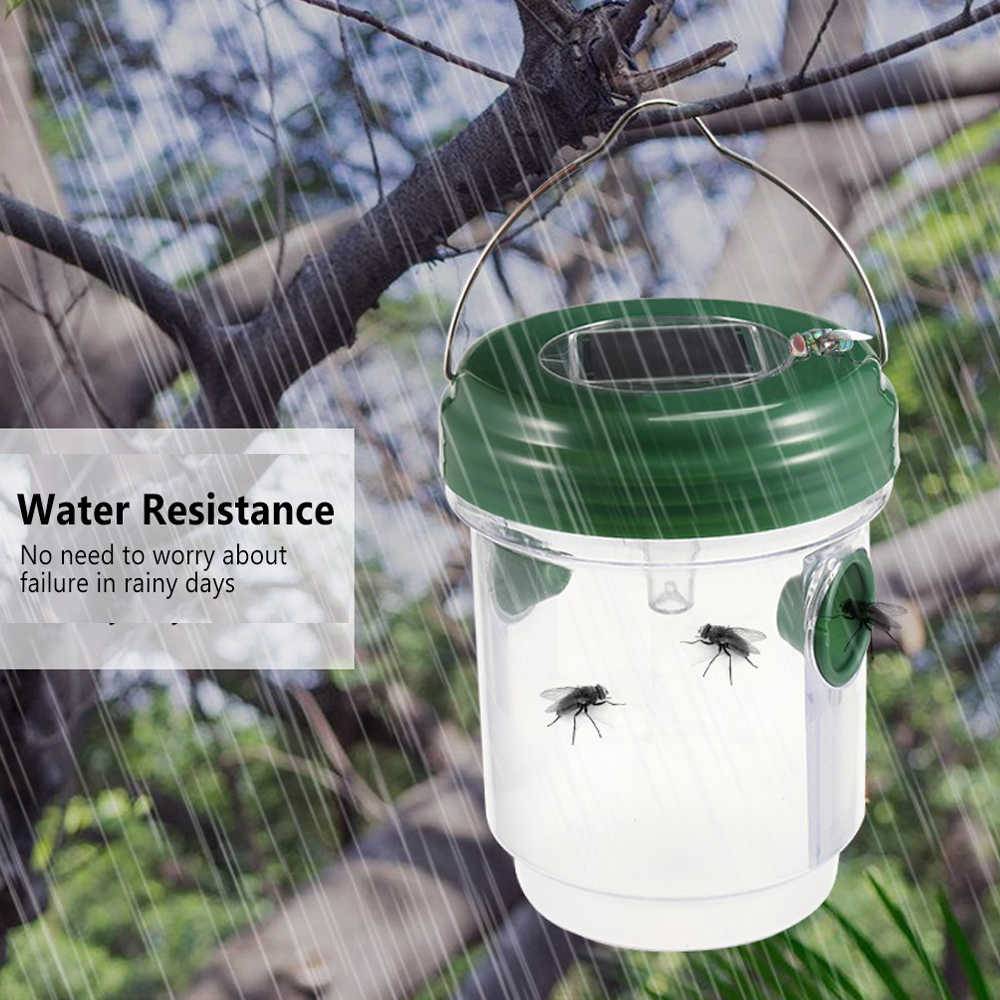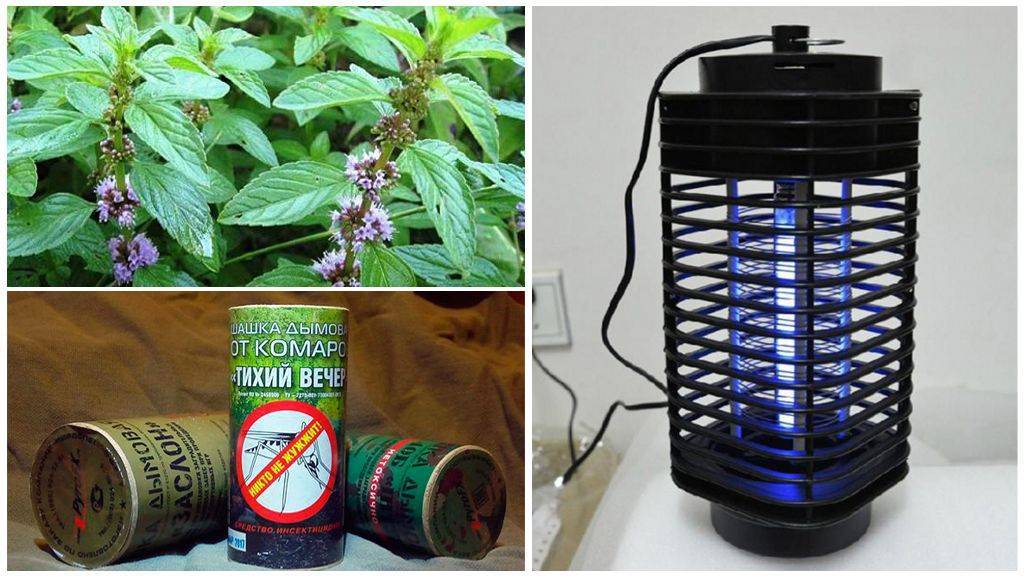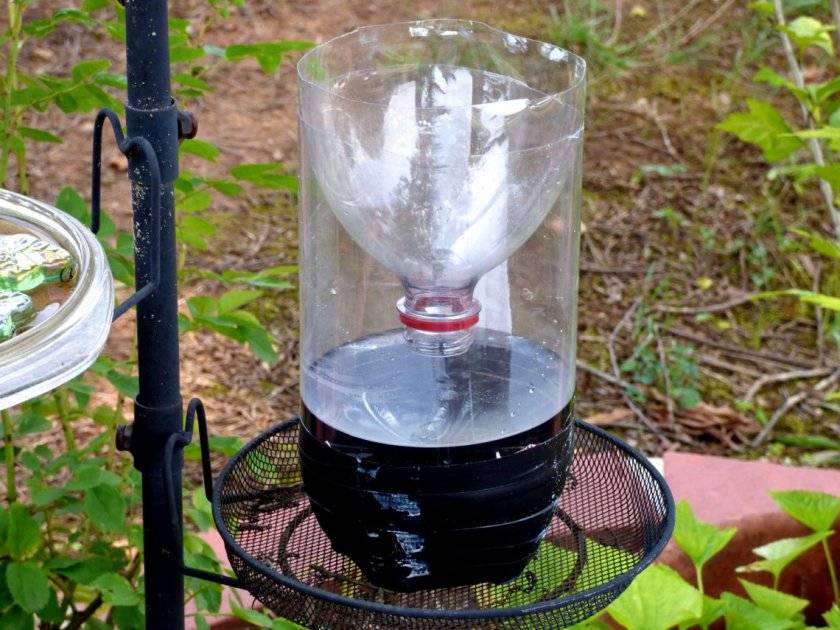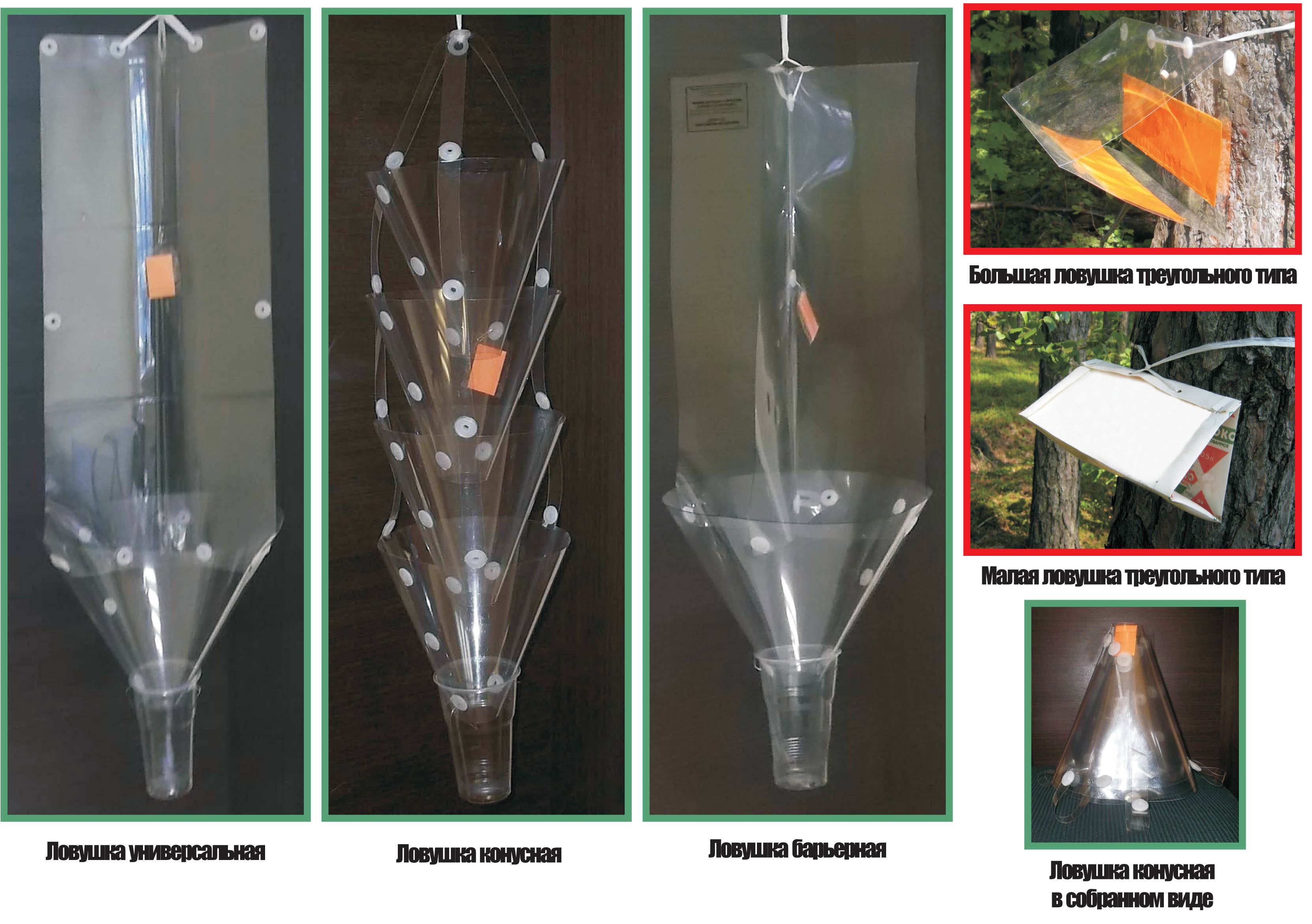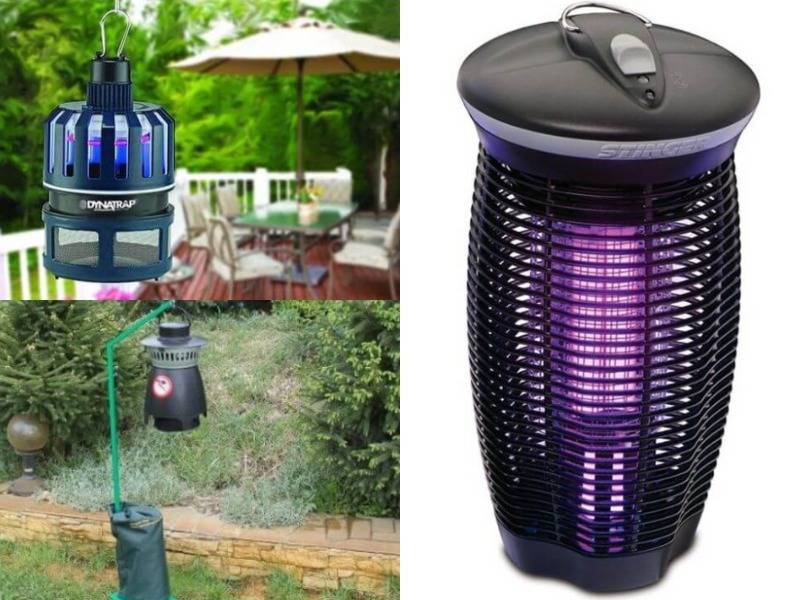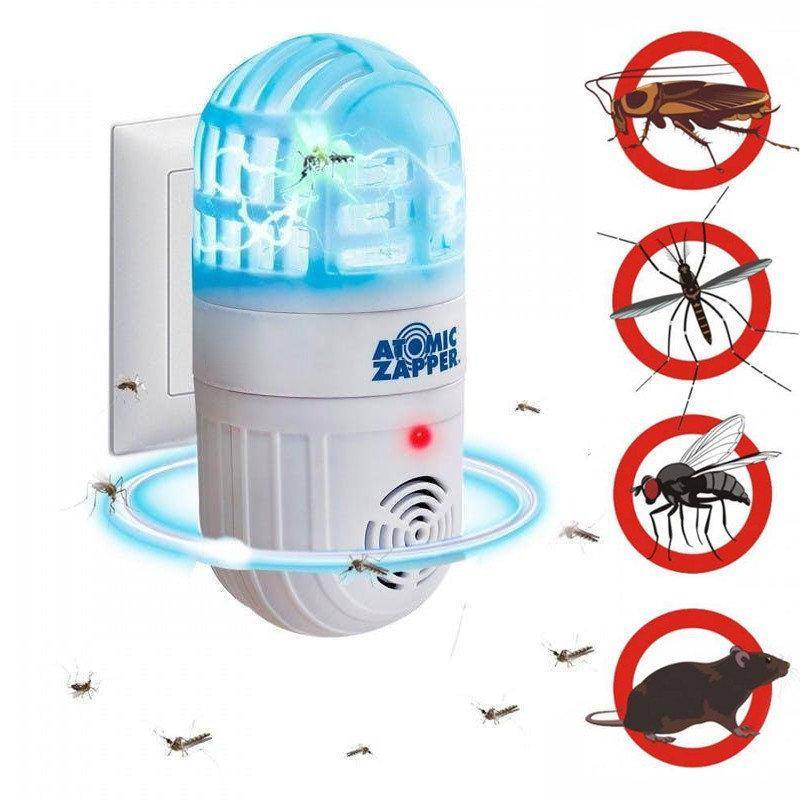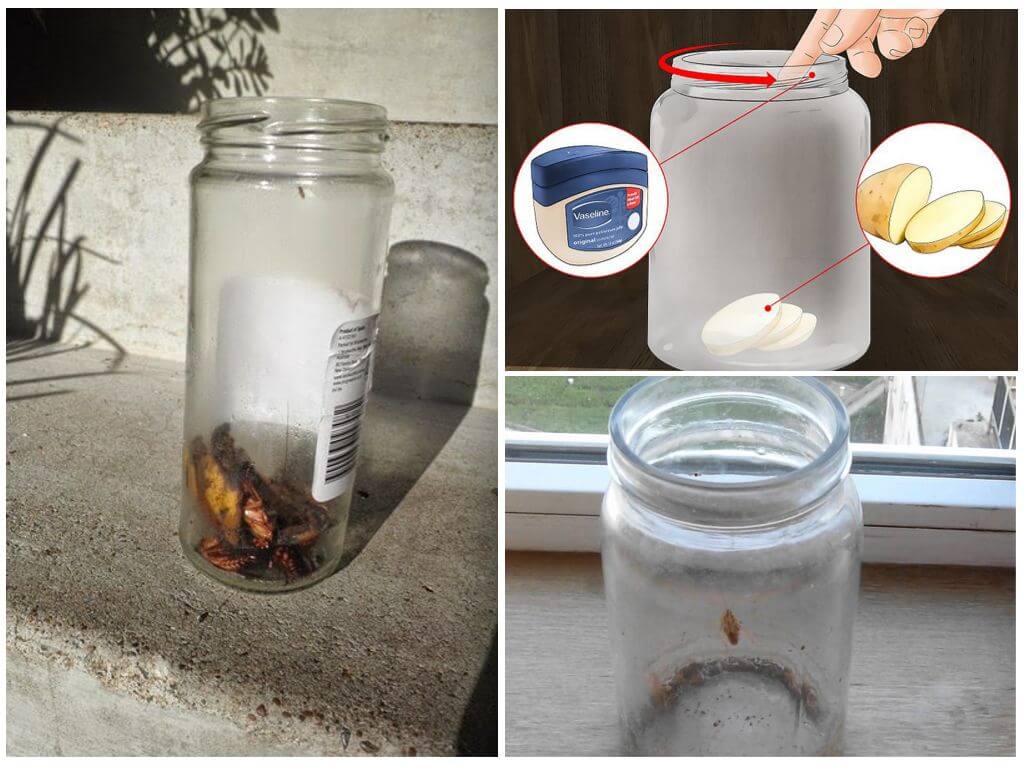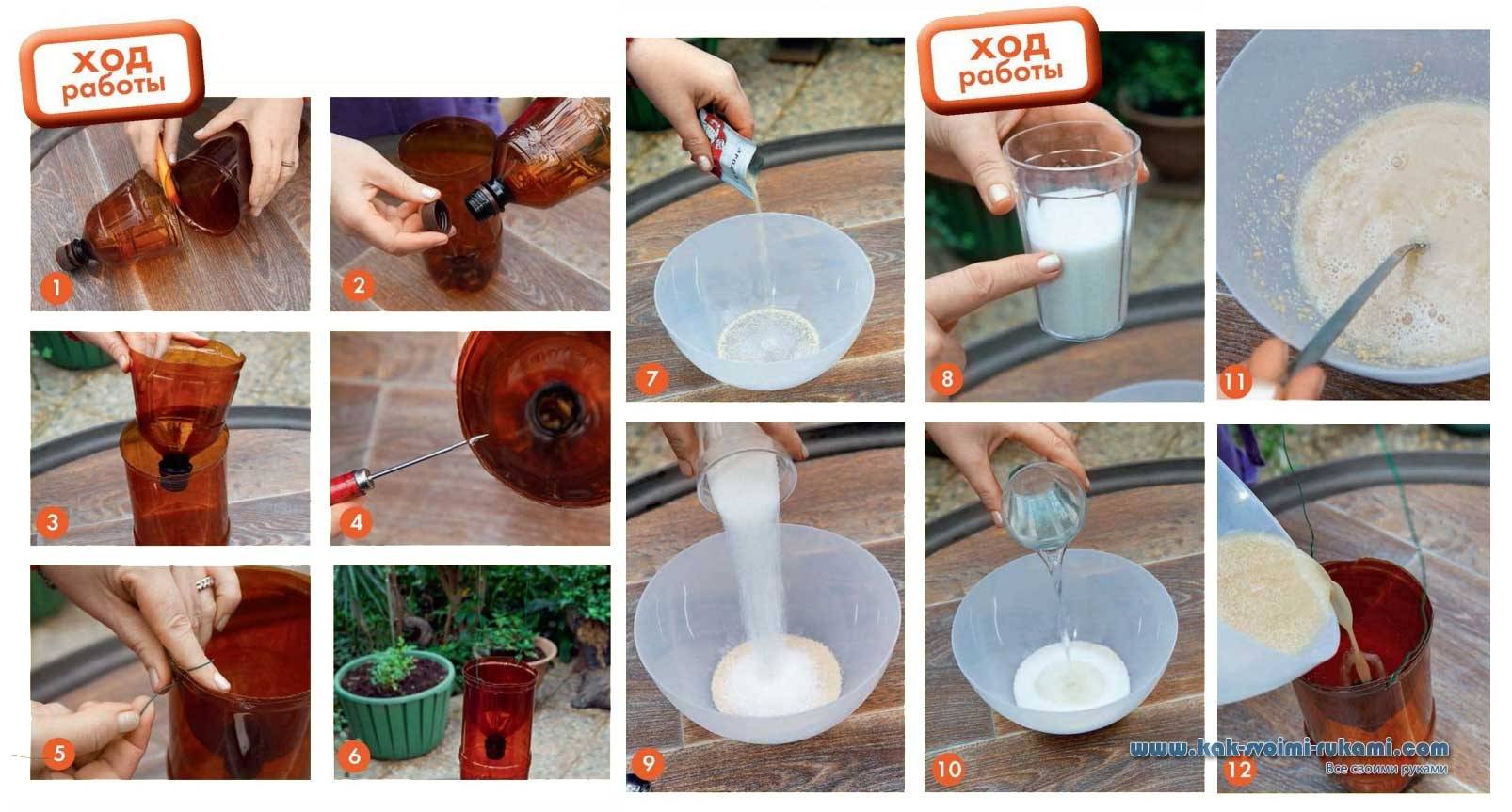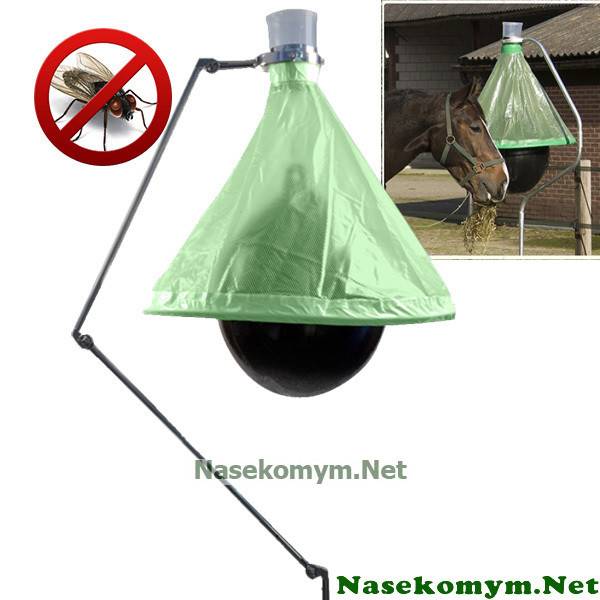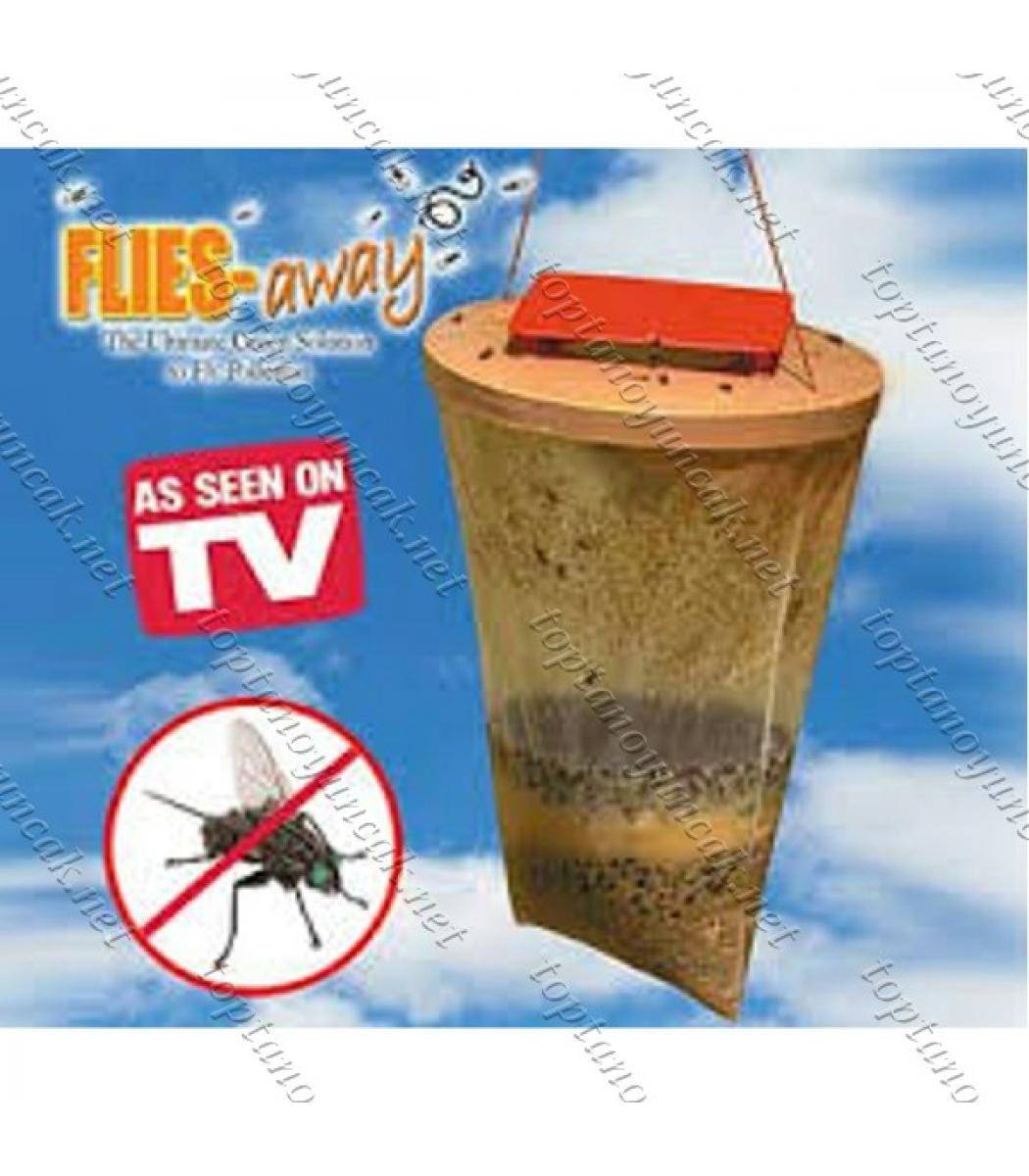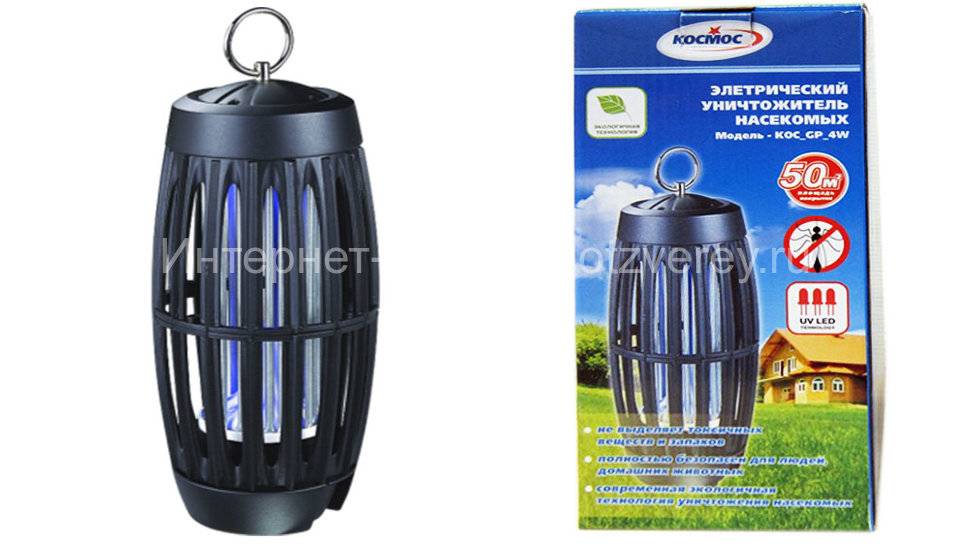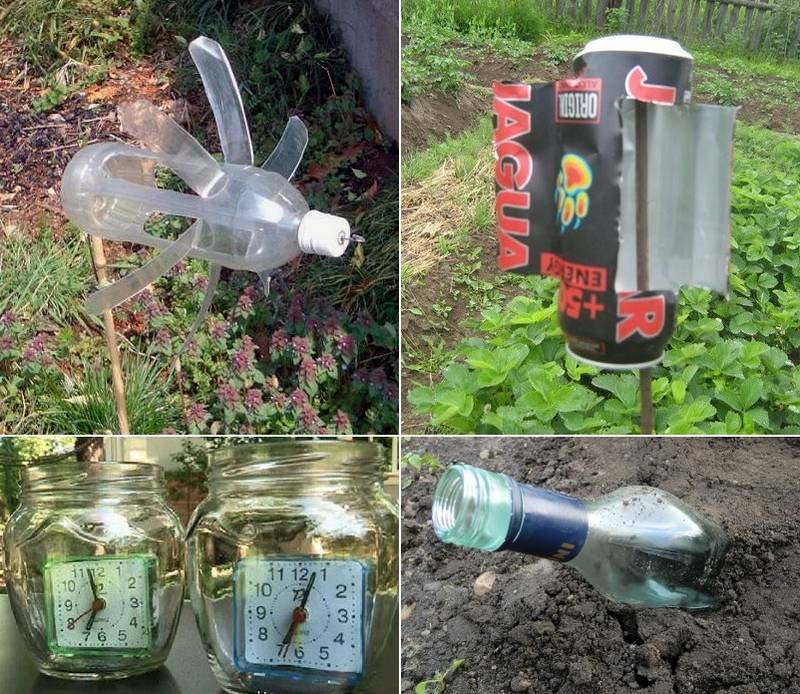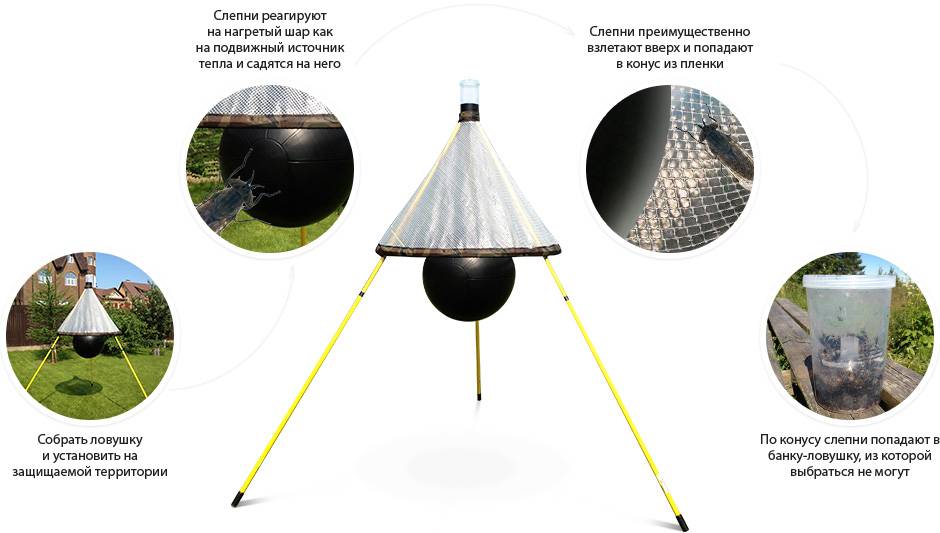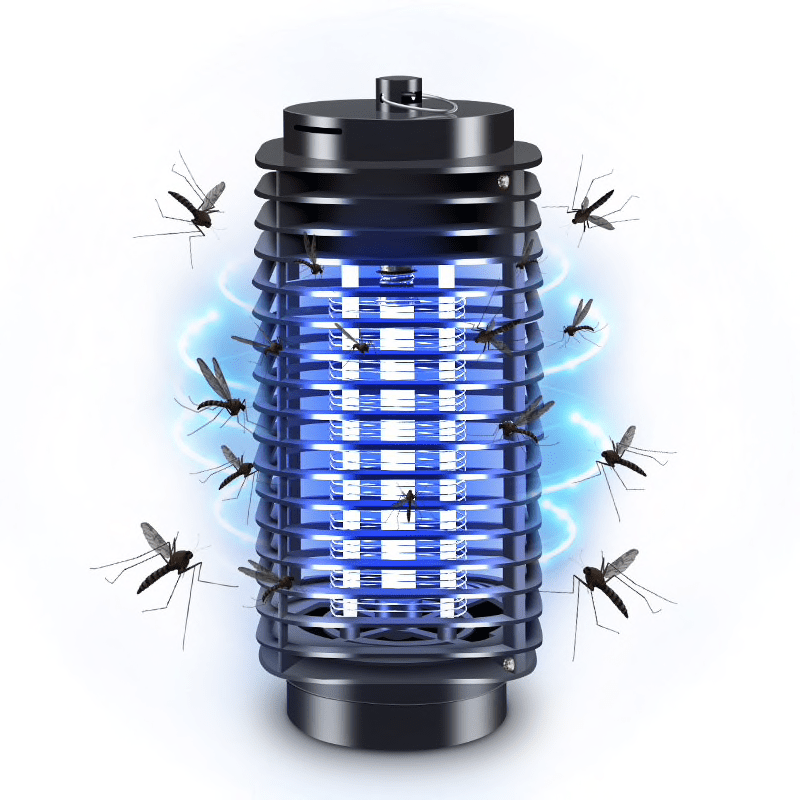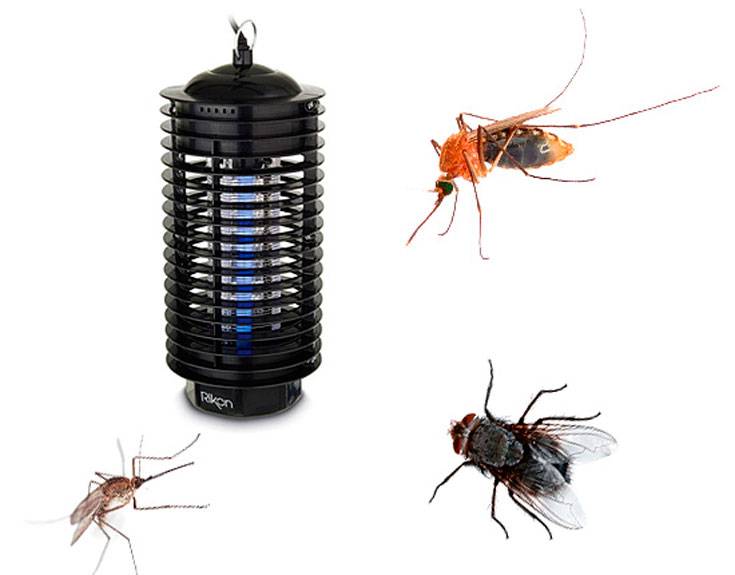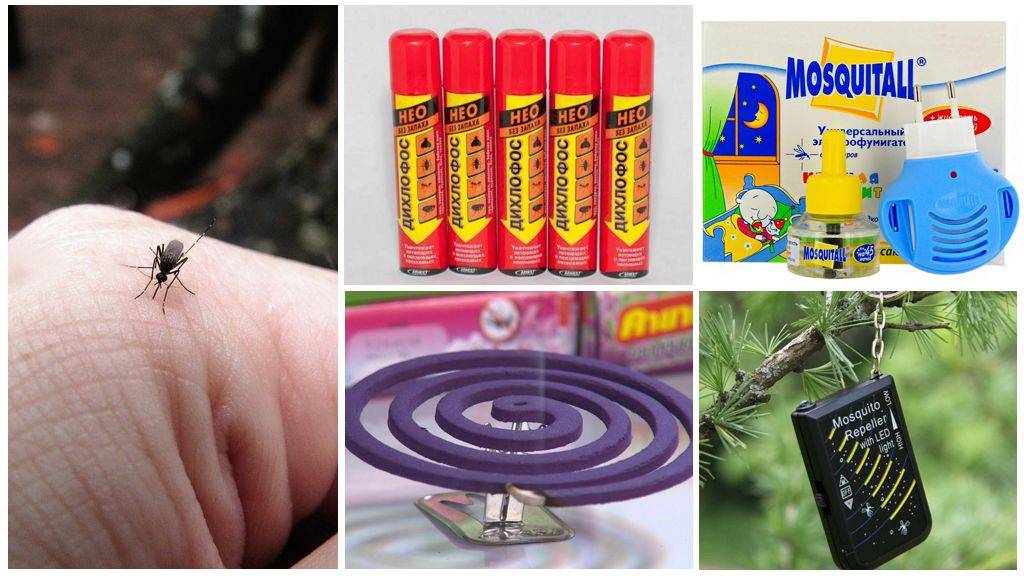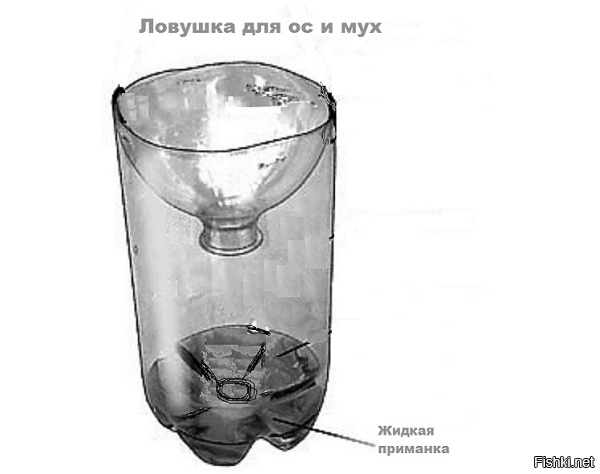The prettiest option is the Australian bollard trap
This trap can be used outdoors - for example, near a dining table under a canopy in the country, since its catching ability is quite high, and maintenance actions are extremely rare.
Outwardly, the flycatcher looks like a bedside table made of a wooden frame with small legs, covered on all sides with a fine mesh, under the bottom of which a saucer with a sugar-containing liquid is placed. The secret of catching flies lies in the pyramidal shape of the mesh bottom of the trap, in which there is a hole. As a rule, when they are full, the flies fly up, not paying attention to the transparent mesh. As a result, insects enter the flytrap through a hole in the bottom.
The following materials are required for manufacturing:
Wooden planks about 30 cm long.
Awnings.
Hinged hook with bracket for securing the lid when closed.
Self-tapping screws for wood and metal.
Metal fine mesh
It is important that a fly cannot get into the cell.
Sealant .. The process of making a flycatcher is as follows:
The flycatcher manufacturing process is as follows:
- Assemble the frame from wooden planks in such a way that the whole structure stands on legs about 5 cm high, attach the upper part to the awnings and equip it with a crochet.
- Cover all sides except the bottom with a metal mesh.
- Make a pyramidal bottom of the trap from the mesh by connecting the seams of the mesh with self-tapping screws for metal; you can also use staples for a furniture stapler for this.
- Attach the bottom to the trap frame with wood screws.
- Cut a hole 2 cm in diameter at the top of the pyramidal bottom so that flies can enter the trap through it.
- Coat all joints between the mesh and the wooden planks with sealant.
- Place the trap in the required place, after placing a saucer with a luring liquid under it - sugar syrup or jam. Commercial fly attractants can also be used.
The advantages of this flycatcher are that it is a rather rare service, since sometimes it is only necessary to free the flies from the trap, and also to replace the luring liquid in the saucer.
Types of flies
The most familiar to us and often found in our area is the housefly, it comes from Asia. Its body is dark gray with a brown tint and black longitudinal stripes.
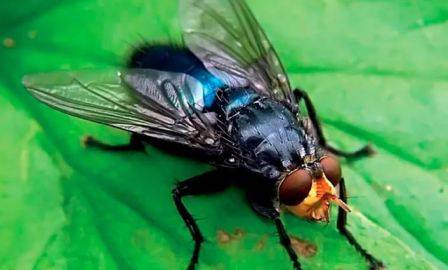
We also have a green fly ("meat"). She has a large emerald-colored body. This is a very annoying species of insects that are attracted by meat waste and sewage.
In nature, you can find hoverflies, their small body is similar in color to a hornet. They are quite harmless, do not bite and emit gurgling sounds.
Plant flies are flower flies. Depending on the "favorite" objects, they are called differently: iris, cherry, onion, beetroot, etc.
Flower flies outwardly resemble ordinary flies, but their body is more graceful. The body of a flower fly is dark gray with yellowish spots. They pierce a young flower bud and lay their eggs in it.
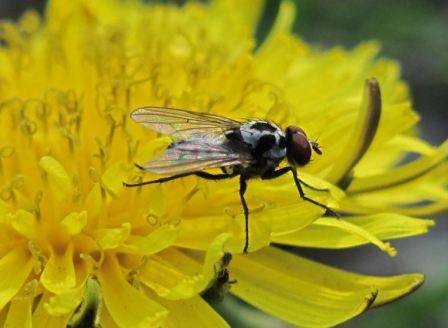
The larvae, hatching from the egg, eat the flower. As a result, it decays. The larvae themselves fall to the ground and, having turned into pupae, hibernate in the soil. The next year, the pupa turns into a fly and this cycle begins anew.
How to get rid of flies quickly and effectively?
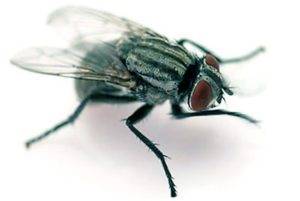 Flies in the house? Not the most pleasant company. In the spring, the number of insects in the apartment increases, and the question arises of how to get rid of flies and make sure that they do not appear again.
Flies in the house? Not the most pleasant company. In the spring, the number of insects in the apartment increases, and the question arises of how to get rid of flies and make sure that they do not appear again.
Before starting the fight against these flying insects, it is necessary to determine where they come from, otherwise all efforts will be in vain. So, let's figure it out.
During the warmer months, they can fly in from windows, balconies, doors, and even from vents. It so happens that the street has not yet warmed up, but they are already flying in the house.
These are insects that in the fall hid in cracks, secluded places for hibernation, and in the spring they come to life again and begin their "mission" of annoying people.
If there is even the slightest hint of unsanitary conditions in the apartment, then flies will choose this place, because they are attracted by the smells of rotting food and dirt.
The annoying buzzing, flights from one place to another, "travel" through food and your body cause irritation and psychological discomfort. It would be easier if the harm from insects was limited only to unpleasant emotions. They can be very dangerous to humans.
How to get rid of flies in the house in the country
Insects cause inconvenience not only in the apartment, but also in the country. In order not to resort to the use of chemistry that is aggressive for people and nature, many are wondering how to get rid of flies without dichlorvos and is it possible.
Such a trap, unlike a store trap, is harmless to pets and does not contain hazardous chemicals:
Bank trap
To make a trap, you will need an empty can (half-liter or liter); water; sweets (optional: honey, sugar, jam); paper.
Fill the jar with sweet water. Roll the paper into a cone, cut off the top so that the fly can get to the "treat". Insert the cone into the jar so that its top does not come into contact with the liquid. Flies will fly on the smell, crawl into the jar, but will not be able to get out.
The paper cone can be replaced with a cut-bottom plastic bottle. Due to the fact that the bottleneck is wider, the insect's chances of getting out of captivity increase significantly. The advantages of plastic over paper - the bottle will not get wet from moisture.
Add vinegar to the water. The acid will poison the insect. Even if the fly gets out of the trap, it will definitely die.
Homemade Velcro
Heat rosin and castor oil, add honey to them. Apply the adhesive mass that forms as a result of heating onto cardboard strips.
Such a velcro will gather flies on itself, prevent them from flying around the house, multiplying and spreading bacteria.
Vinegar trap
The principle of such a trap is similar to a trap in a jar. The only difference is that the container is closed with cling film, in which a small hole is cut. Vinegar is poured into the jar with the addition of detergent.
The detergent forms a soapy film that prevents flies from getting out and flying away if they get into the jar. Vinegar is an insect poison.
Black pepper treat
Flies do not tolerate black pepper, moreover, it kills them.
Brew the sugar syrup, add black pepper and leave in a small container when you leave.
The syrup will make the flies' legs heavy and prevent them from flying away from the feeder. Black pepper will kill the annoying insect.
Insects do not tolerate walnuts, elderberries and bird cherry. Plant them around your country house. The grown trees will delight the eye and scare off flies.
Another way to scare away insects is to treat window and door frames with water with the addition of turpentine or castor oil. In the fresh air, the smell will quickly disappear and will not be noticeable to humans. Insects, which have a very delicate sense of smell, will hear a scent that repels them for a long time.
There are many ways to deal with flies and other insects.
The modern chemical industry offers an endless list of products, sprays, powders, poisonous insects. Unfortunately, these products are not safe for people and pets.
Knowing what smells, plants and substances scare off flies, you can effectively deal with them using folk methods that will not harm your health.
Insecticides and poisons
As soon as the housewives are faced with an infestation of flies, they rush to use Dichlorvos. There are other means to poison them.
"Agita 10WG"
The drug is effective in killing insects such as flies. It is a new generation insecticide. The powder has a high concentration of active ingredient. To prepare the poison, the powder is diluted in water and sprayed on the walls with a spray bottle.
"Minap 22"
The product is safe for humans and at the same time has a destructive effect on flies. Remains effective after the first application for 6 months. After preparing the solution, they are treated with places where insects accumulate. If necessary, the entire walls are washed.
"Executioner"
Suitable for killing flies in any room. Has the appearance of a liquid. The composition contains cypermethrin, fenthion and various technological additives.
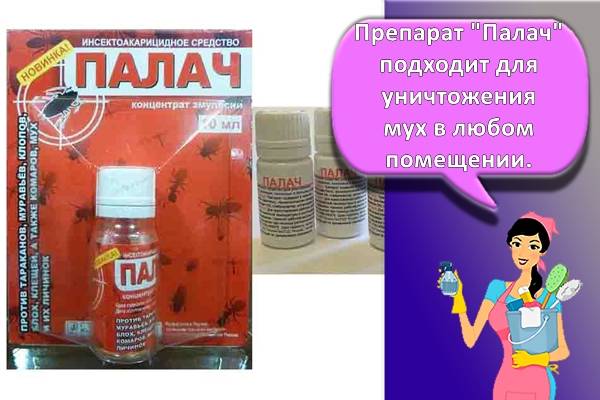
Get
If a person is looking for something to poison flies, Get is an excellent solution. Combines an unusual form of release and a unique formula that is highly effective. The microcapsules contain a poisonous substance. After contact with the drug, the insect dies.
Flybyte
There is another contact poison on the market - Flybyte. The bait works 10 minutes after unfolding. Thanks to the active substance methomil, insects lose their resistance. The substance continues to kill insects for 2-3 months.
Homemade poison
To control flies, you should start with homemade products. And only after that switch to chemical compositions. Those who have had time to deal with the invasion of insects recommend using one of the indicated recipes for preparing the poison:
- milk-formalin mixture;
- composition of milk, pepper and sugar.
In the first case, a person will need 60 ml of milk, 1 tsp. formalin, a pinch of baking soda and 8 tbsp. l. Sahara. All ingredients are mixed and poured into small plates. A piece of bread is laid out in the center of each.
The poison according to the second recipe is also easy to prepare. It will take 2 tbsp. l. ground black pepper, a glass of milk and a pinch of sugar. In the finished composition, paper towels are impregnated. Each is placed on a saucer, and then they are placed in places where flies like to land.
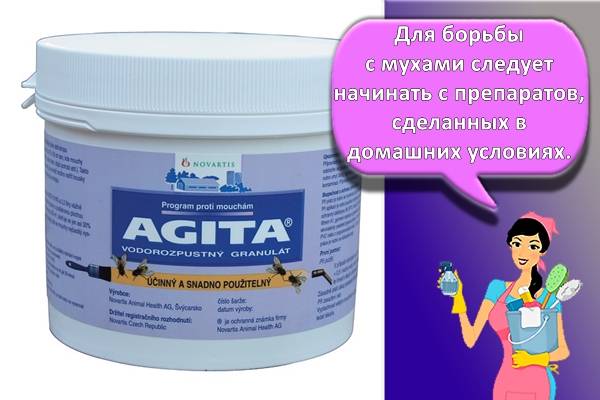
Trap bait
A suitable bait will be a light bulb with a bayonet base, as well as a holder for it. The surrounding air will heat up and illuminate the space at the same time. Everyone knows that light is the main bait for insects. Instead of a light bulb, you can use LEDs. Moreover, it is more economical to buy them in the tape, and not separately. In addition to light, you will need another bait. Komarov will be interested in carbon dioxide, for which you will need to dilute the same amount of sugar and 5 g of yeast in 0.5 cups of water. The bait should be added to the container to be attached to the body of the trap.
These are the easy but effective methods for dealing with flying insects. They are much safer than aerosols and other chemicals. Therefore, it is better to spend some time making your own trap than spending money on other methods of fighting insects.
Interesting about flies
Readers now know how to make a fly and wasp trap. Surely many are also interested in what goals the insect pursues. If bees live to make honey, then flies and wasps pursue completely different goals. They try to lay as many eggs as possible. One fly manages to reproduce up to 2000 larvae. Moreover, they live only a couple of months, and sometimes up to two weeks. For one clutch, the fly lays about 120 eggs.
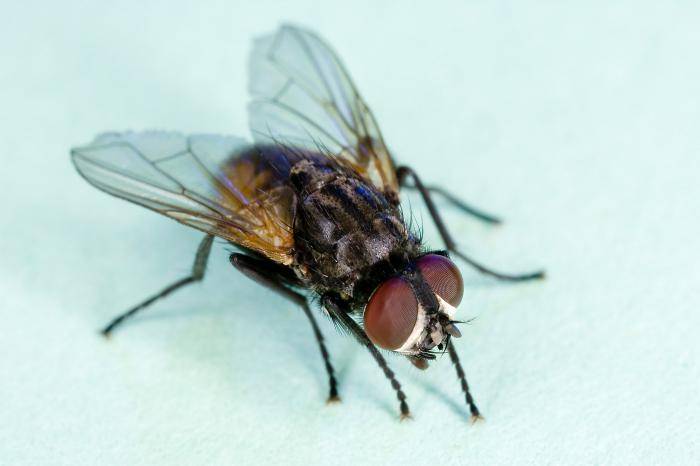
A sump, compost heap, and even soil in a flower pot are best suited for this. The fly will appear in a couple of weeks. Moreover, the warmer the ambient temperature, the faster the larva matures. Flies sleep in winter. An active life begins only when the total daily temperature is +20 degrees. There is another interesting fact.Surely many are interested not only in how to make a trap at home, but also in why flies are always sitting on the windows. They just have compound eyes, because they simply do not notice transparent objects.
Preventive measures against flies
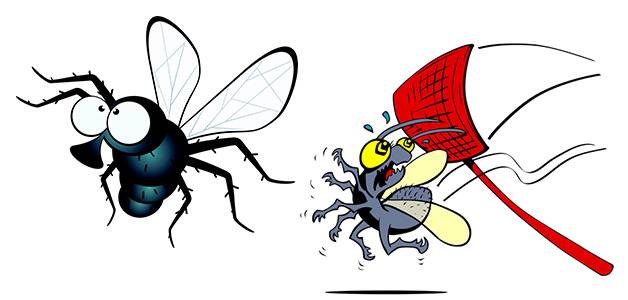
It is better to think in advance that there are no flies in the house than to fight them every day. To avoid insects in your home, just follow some tips. For example:
- You need to quickly get rid of garbage and waste. Flies are able to determine acceptable places for themselves at a great distance. They are especially attracted by the smell of meat and fish. The waste of these products should be disposed of in advance.
- The trash can also needs to be kept clean, or even better, use special trash bags.
- All food products should be stored exclusively in the refrigerator, and in nature they should be covered with gauze.
- Flies just love dirty dishes. In this regard, the dishes should be washed immediately after each meal.
- In the presence of pets, their food should be constantly hidden after each meal. This approach will allow not only to get rid of flies, but also to accustom the animal to the regime.
- Mosquito nets are very popular nowadays. When installing plastic windows, all owners install mosquito nets. This allows you to solve the issue with the appearance of not only flies in the house, but also other insects. The main condition is the absence of gaps.
- If there are no mosquito nets, then foil can be glued to the windows, which will scare away insects.
- If a lot of flies have flown into the room, then they can be driven out with a rag and a switched on light source. In this case, you need to open a window.
- It is difficult to get rid of flies in a private house, especially if the owners breed all kinds of animals. To have fewer flies, it is necessary to clean up more often in animal cages, and it is better to sprinkle latrines with bleach. The drain hole must be covered with a lid, otherwise flies will breed in it.
Flies have accompanied humans for thousands of years. During this time, a person was able to come up with many ways to get rid of these annoying insects. Some of the methods of struggle are quite simple and do not require much effort. To keep fewer flies around, it is better to adhere to basic sanitation rules.
How to get rid of flies in the house forever
Homemade fly traps in the house
If you cannot go for poison due to lack of money or when you do not have the necessary homemade ingredients, you can build your own homemade traps. Making a fly repellent at home is not difficult if you have half an hour of free time.
 If you cannot go for poison due to lack of money or when you do not have the necessary homemade ingredients, you can build your own homemade traps.
If you cannot go for poison due to lack of money or when you do not have the necessary homemade ingredients, you can build your own homemade traps.
There are, like complex traps that require high costs, and there are lighter options that are no less effective. A few simple items to destroy all flies in a matter of days:
- cut bottle;
- dampened cloth.
Cropped bottle
Simple work can rid the room of flies for a long time. In order not to run after insects on your own, the "cut bottle" trap will come to the rescue. To create this bait, you do not need to buy special materials for flies. All you need:
- banana;
- sugar;
- bottle;
- knife.
If you follow the instructions, the trap will prove to be very effective against flies for a week:
- Using a knife, cut the bottle in half in the middle. The bottom must be larger than the top in a ratio of 3 to 1.
- One tablespoon of sugar must be thrown into the larger part to fill the bottom.
- Cut the banana into small pieces with a knife and put the contents in a bowl of sugar.
- Squeeze the banana a little until it forms a small gruel.
- Add 5 cm of water.
- Turn over the smaller part of the bottle, unscrew the cap and place the neck in the porridge socket upside down.
What is the danger from flies indoors
You can't keep track of annoying flies at what moment they sit down for your favorite breakfast or lunch, when they stain your clean towel with their infected paws, and so on. This is precisely the danger when flies have chosen your room - they are carriers of a number of infectious, fungal and bacterial diseases. Perhaps this is the most basic danger from flies for humans, in addition to their importunity, when they strive to sit on their faces.
The fly is capable of perching on anything. She especially loves decay products - rotting food, fruits, vegetables, meat, fish, and more. Then, on her paws, she transfers the pathogenic microflora to clean food, objects and things in the house or other room. After a person touches an infected object or eats food contaminated by flies, the human body becomes infected.
What scares off flies
When these insects appear in the house or in the yard, especially if they appeared immediately in large numbers, it is necessary to start an immediate fight.
The main helpers of a person in such a difficult task are, first of all, some plants, capable of scaring away uninvited guests with their pungent smell:
- geranium or lavender, which is enough to place on the windowsills of your house;
- tansy, wormwood, bracken fern: bunches of these plants can also be laid out on the windowsill or hung in the corner of the room;
- peppermint, which can be used both fresh and dried;
- bay leaf: it is known that flies die from the smell of this plant after a couple of minutes;
- wild rosemary, mountain ash and chestnut leaves, juniper branches, dry peel of citrus - all this also has a detrimental effect on flies.
The smells of kerosene and vinegar can scare off these unpleasant insects. So, in order to combat flies, it is recommended to use sponges or rags dipped in vinegar and spread out near the windows or in the kitchen, but it is permissible to rinse the floor with water with a small addition of kerosene (40 ml per bucket of water), which, of course, is undesirable if in the house small children or animals are present.
Folk remedies for flies and mosquitoes
A good alternative to the well-known advertised means are all kinds of folk recipes. Let's take a look at some of them.
- A homemade poison that can be obtained by mixing two teaspoons of sugar and a teaspoon of black pepper. This mixture should be scattered into small saucers and placed in places where flies are most present.
- The same should be done with the solution obtained by mixing milk, formalin and sugar.
- An excellent fly bait is based on saccharin, the worst enemy of these insects. To obtain it, you will need one glass of water, 2 g of saccharin and 20 g of honey. It is necessary to soak newspapers with such a solution, and then lay them out on the windowsill of your apartment. The flies that land on them will die in the near future.
- Flies and mosquitoes are insects sensitive to strong odors. If you wash windows and doors with a solution of vinegar, vodka, castor oil or turpentine, insects are unlikely to want to enter the house.
- The poison, prepared on the basis of chlorophos, also does its job flawlessly. The recipe for its preparation is quite simple: you need to add half a teaspoon of sugar and ¼ teaspoon of chlorophos to the water, then pour the liquid into small plates and arrange, for example, on kitchen cabinets, that is, in an area inaccessible to children and animals.
The positive effect of using folk methods will only increase if you combine their use with special devices or adhesive tape.
Ready-made devices and devices for controlling flies
To combat hated insects, you can use a special device for exterminating flies. Manufacturers offer a variety of models to make life easier.
Insecticidal lamps come in a variety of shapes and sizes: sconces, floor-standing or tabletop devices. They are powered by electricity, are absolutely harmless to people and can be used indoors around the clock.
How is fly control carried out? The devices emit ultraviolet rays of a certain spectrum, which attract flies. Insects flying close to them die from the current discharge. Many models are equipped with adhesive sheets or a special design that prevents dead insects from falling on the floor, on the table, ensuring high hygiene.
There are devices that attract flies using UV radiation and then suck up the flying insects. Silent operation, hygiene and safety make it possible to use the devices in the house and apartment.
The Insect Killer is an effective and unique fly control device. They are very easy to install and have a range of 4000 m2. It cannot be installed indoors, which is why it is one of the popular models for private houses.
Having installed it in the yard, you can enjoy your vacation without being distracted by annoying insects. The likelihood of flies getting into the house through windows and doors also decreases many times. How does this device work? It produces carbon dioxide, moisture and heat that attract flies. The flying insects are sucked into the net and die there from dehydration within 24 hours.
Velcro shredders or sticky tapes are an effective trap. It is a tape and a sticky sheet. It is enough to hang it in a room with the most flies. They will attract insects with a specific smell. A fly that has landed on them will no longer be able to come off and die.
Breeding flies
To understand that you cannot let the situation take its course, you need to say a few words about the life cycle of these insects. Each individual goes through four stages of development:
- Clutch of eggs. The female can lay up to 150 eggs at a time. This requires a moist environment (rotting compost heap, trash can).
- After 8 hours, larvae hatch from the eggs, and 14 hours develop, feeding on what is around;
- Pupation takes place in a dry place, and lasts up to a month.
- A fly emerges from the pupa. The lifespan of an adult is up to 30 days. During this time, she lays up to 2000 eggs.
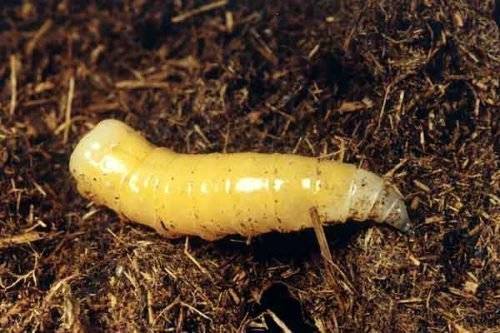
Fly larvae develop in decaying organic matter, manure, less often in living tissues of plants and animals
That is, the appearance of a couple of flies in the house or in the country can cause another 200 individuals to be born in your home in a month. Therefore, if your plans are to quickly get rid of these insects in the country, start fighting them when the first individuals appear.
What is the danger of flies
It wouldn't be so bad if the essence of the problem was only psychological discomfort. However, do not forget that flies are not so harmless insects, because on their paws they can carry thousands of bacteria that cause various serious diseases: helminthiasis, diphtheria, tuberculosis, cholera, anthrax, conjunctivitis, dysentery, salmonellosis, typhoid and typhoid fever ...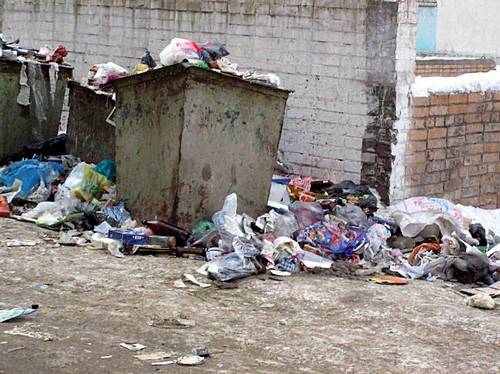
These insects are carriers of such epidemiological diseases for the simple reason that their favorite habitat is feces, compost pits, garbage dumps, and decomposing animal corpses. After walking through all these unpleasant places, flies penetrate into a person's house, sit on food left on the table, on fruits lying in a vase, on jam not covered with a saucer.
And here there is another health hazard: the fly is not only capable of infecting food with bacteria, it can lay the larvae, which later, along with food, enter the human body, which is fraught with skin, gastrointestinal and genitourinary diseases. In addition, some individuals can bite, causing a strong irritant reaction on the skin.
How to get rid of flies in the house with folk remedies
Fighting flies drives housewives crazy. In the summer, these insects invade everything.It is worth opening a window or front door, and flies are right there. It is worth leaving the food on the table unattended for a minute, and these not very pleasant insects are already crawling on it.
The first thing to do to prevent flies from entering the house is to keep it clean and tidy. Here we are not talking about the fact that the conditions should be laboratory
In real life, this is impossible, but pay attention to the lifekahs for the kitchen:
- the trash bin must be covered;
- there should be no food products in access for insects;
- do not leave fruits or vegetables on the table;
- When preparing food, make sure that the work surfaces are clean and do not subsequently become a source of food for flies.
Flies are afraid of vinegar and boric acid. This can be used to repel insects. Dilute acid in water at the rate of: a tablespoon of the substance per liter of water. Treat surfaces that are not in contact with food with the solution.
Knowing what smells flies are afraid of, you can effectively fight these insects in the apartment. So:
- Vodka. Flies are afraid of the smell of alcohol. Spraying the substance around the house, in the rooms, you will scare them away.
- Essential oils. Flies do not tolerate citrus, eucalyptus, lavender, clove and peppermint scents.
- Laurel. Insects are afraid of the smell of bay leaves, both dry and fresh. Spread the leaves in secluded places where they will not interfere with anyone. The scent will scare away not only flies, but also small midges along with rodents.
- Lavender. This plant will not only decorate the house and fill it with aroma, it will help get rid of annoying flies. Plant the lavender in pots and arrange them over the windowsills. Spread the lavender slices around the house.
- Mint. Peppermint effectively repels insects and rodents. Spread out fresh mint leaves or use dried plant flowers.
- Carnation. The twigs of the plant can be put in a vase, laid out around the house, in the kitchen. Stick the dried clove buds into the cut lemon. Their smells will mix and give the flies a lot of unpleasant sensations.
- Basil. It can be grown in containers in a private home. The plant does not lose its properties when dried. Prepare in advance sachets with dried basil, spread in secluded corners. Insects will hear the smell of a plant, which they do not like at all.
- Tansy. From tansy, you can tie bundles and hang them around the house. It will look original and help get rid of flies.
- Sagebrush. This plant is famous for its ability to repel insects. Wormwood gives off a pungent odor, but effectively fights flies and other parasitic insects.
- Tomatoes. Flies are scared away not so much by the fruits of the plant as by the smell of tops and seedlings. Stems cut from a tomato bush can be chopped and spread in the house, on the refrigerator, on the tops of furniture. Plant tomato seeds for seedlings and arrange trays on the windowsills.
- Geranium. This plant is useful not only in the fight against insects. Geranium is an effective antiviral agent and is famous as a plant that purifies the air in the rooms where it grows.
How to get rid of annoying flies and which means to use, decide for yourself. Fragrant herbs have a rather peculiar smell. In case of individual intolerance, it is better to refuse to use certain products in the house.
Flies in the house: modern and folk methods of struggle
With the first spring sun and warmth from hibernation, many insects wake up, some of which flood our homes. Flies are some of the most unpleasant. A parasite of the Diptera order, a type of arthropod. There are several hundred species of these insects. In everyday life, we often encounter house flies. They feed on liquid substances, garbage, food residues. Having the opportunity to sit down on any waste, corpses of animals and other insects, simple houseflies become carriers of viruses, bacteria and various diseases that are dangerous to humans.


